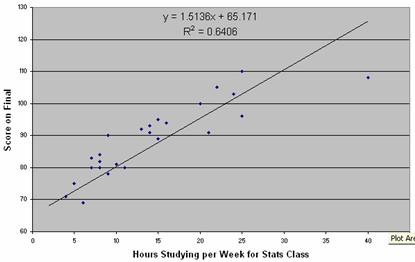How to build efficient systems of
spreadsheets to save time, get promoted and have extra time for vacation
An Excel book that takes you from the beginning
theories of how to construct efficient systems of spreadsheets towards the
Beautiful Excel infinity at the other end
By Michael “Excel Is Fun!” Girvin
Warning, because this book is free, I
could not afford an editor. So you will have to put up with the occasional
spelling/grammatical error. If you find any kind of error, please e-mail me at
mgirvin@highline.edu.
Dedication:
This book is dedicated to Dennis “Big D” Ho, my step-son,
because he loves books so much!
Table of
Contents
Introduction. 4
What
Is Excel?. 5
Rows,
Columns, Cells, Range Of Cells. 6
Worksheet,
Sheet Tab, Workbook. 7
Menus
And The Alt Key. 9
Toolbars. 10
Save
As is different than Save. 10
Two
Magic Symbols In Excel 11
Math. 17
Formulas. 21
Functions. 26
Cell
References. 36
Assumption
Tables/Sheets. 51
Cell
Formatting. 61
Charts. 85
Analyze
Data. 95
Conclusion: 103
Excel is Fun! Why? Because your
efficient use of Excel can turn a three hour payroll calculating chore or a
five hour reporting task into a five minute breeze. You save a lot of time.
That time adds up to extra time for your more enjoyable endeavors in life such
as vacations! In addition, your bosses and employees will notice that you are
efficient and can produce professional looking reports that impress. This of
course leads to promotion more quickly. Still, further, your knowledgeable and
efficient use of Excel can land you a job during an interview. Employers are
like dry sponges ready to soak up any job candidate that can make their entity more
efficient with Excel skills! Save time?, get promoted?, get the job?, and have
more time for vacation? – That sounds like a great skill to have!
In the working world, almost
everyone is required to use Excel. Amongst the people who are required to use
it, very few know how to use it well; and even amongst the people who know it
well, very few of those people know how to use it efficiently to the point
where grace and beauty can be seen in a simple spreadsheet!
This handout will take you from
the very beginning basics of Excel and then straight into a simple set of
efficiency rules that will lead you towards Excel excellence.
You use Word to create letters,
flyers, books and mail merges. You use PowerPoint to create visual, audio and
text presentations. You use Google to research a topic and find the local pizza
restaurant. You use Excel to make Calculations,
Analyze Data and Create Charts. Although databases (such
as Access) are the proper place to store data and create routine calculating
queries, many people around the planet earth use Excel to complete these tasks.
Excel’s row and column format and ready ability to store data and make
calculations make it easy to use when compared to a database program. However,
Excel’s essential beauty is that you can make calculations and analyze/manipulate
data quickly and easily “on the fly!” This easy to use, planet earth “default”
program must be learned if you want to succeed in today’s working world.
Open up The Excel Is Fun!.xls
workbook and click on the “What is Excel” sheet tab
Here is an example of how Excel
can make payroll calculation quickly and with fewer errors than by hand (Figure
1):

Figure 1
Here is an example of how Excel
can manage data, sorting by time, quickly and with fewer errors than by hand (Figure
2 and Figure 3):

Figure 4
Rows are horizontal and are
represented by numbers. In our example (Figure 4)
the color blue has been added to show row 5.
Columns are vertical and
represented by letters. In our example (Figure 4)
the color yellow has been added to show Column B.
A cell is an intersection of a row
and a column. In our example the color green has been added to show cell B5. In
our example column B and row 5 can be detected because the column and row
headers are highlighted in a light-steel-blue color (Figure 4). In addition, you can see that the name box
shows that cell B5 is selected (Figure 4 and
Figure 5).

Figure 5
B5 is the name of this cell. It
can be thought of as the address for this cell. It is like the intersection of
two streets. If we wanted to hang out at the corner of Column B Street and Row 5 Street, we
would be hanging out at the cell address B5.
Later when we make calculations in Excel (making formulas),
B5 will be called a cell reference.
A range of cells is two or more
cells that are adjacent. For example you can see three blue cells D9, E9, and
F9. This range would properly be expressed as D9:F9, where the colon means from
cell D9 all the way to cell F9

Figure 6
A worksheet is all the cells
(65536 rows, 256 columns worth of cells). A worksheet is commonly referred to
as “sheet.”
The Sheet tab is the name of the
sheet. By default they are listed as Sheet1, Sheet2. In our example (Figure 6) the sheet we are viewing is named “Rows and
Columns.” You can see other worksheets that have been given names in our
example. Can you say what they are?
Naming your sheets helps you to
keep track of things in a methodical way. Navigating through a workbook,
understanding formulas and creating headers/footers is greatly enhanced when
you name sheets. To name your sheet, double-click the sheet tab (this highlights
the sheet tab name) and type a logical name that describes the purpose of the
sheet. Navigating through a workbook, understanding formulas and creating
headers/footers is greatly enhanced when you name sheets.
A workbook is all the sheets (up
to 256 worksheets). To name your workbook click the File menu and then Save As (Keyboard Shortcut = F12). Figure
7 shows the Save As dialog box:

Figure 7
Save in = Where do you want to
save it?
File name = what do you want to
call it?
Save as type = what type of file
is it? (.xls? or .htm? or .xlt?)
Naming your workbook helps you to
find it later and helps to create headers/footers.
Menus allow you to access many of
Excel’s wonderful features. For example, if you want to change the page setup
from portrait to landscape, you could click the File menu and then click on
Page Setup as seen in Figure 8 Figure 9:


Figure
8 Figure
9
Notice that “File has an
underlined F and that Page Setup has an underlined u. Now
try to open up Page Setup with this keyboard shortcut: Hold down the Alt key,
then tap F once, then tap U once. The keyboard shortcut for opening Page Setup = Alt + F + U.
Also notice in Figure 8 Figure
9 that your menu may not have the MegaStat
menu. Don’t be alarmed. Not all menus are exactly the same. This is because you
can edit them and personalize them to suit your own needs.
Copy = Ctrl + C
Cut = Ctrl + X
Paste = Ctrl + V
Add bold to cell content = Ctrl + B
Add Underline to cell content = Ctrl + U
Add Italic to cell content = Ctrl + I
Select two cells and everything in-between = Click on first cell, hold
Shift, Click on last cell
Select cell ranges that are not next to each other = click on cell or range
of cells, Hold Ctrl, click on any number of other cells or range of cells
Ctrl + arrow key = move to end of range of data, or to beginning of next
range of data
You can click on toolbar icons to
access many of Excel’s wonderful features. For example, you could highlight one
cell in the column of times and click the Sort Ascending button as seen in Figure
10 (notice when you hover your cursor
over a button, a screen tip pops up and names the button – in our case it says
“Sort Ascending”):

Figure 10
You could also click the Save,
Spelling and Undo buttons as seen in Figure 11:



Figure 11
However, instead of using these
three buttons learn your keyboard shortcuts: Save = Ctrl + S, Spelling = F7, Undo = Ctrl + Z.
Save and Undo are your best
friends. Save often so that when your computer crashes you don’t have to do
double work. Use undo when you accidentally do the wrong action. You can also
use Save and Undo in tandem: Click Save before you want to try a risky maneuver,
then try the risky maneuver up to 16 actions. Then click undo to go back to the
point where you saved (the down arrow next to Undo will allow you to highlight
a few undoes, click, and that will undo multiple actions).
Look at the toolbar in Figure 10, then go back and look at the toolbar in Figure
6. They are both different (these are
actual screen shots from my two different computers). Don’t be alarmed. All
toolbars are not the same. This is a good thing because it means that they are
customizable (a topic for a later time).
Save updates the already saved
file by replacing the stored file with the most recent changes.
Save As gives you the power to: 1)
Save the file to a new location 2) save file with a new name 3) change the file
type such as a template (.xlt), an earlier version of Excel (Microsoft Excel
5.0/95 Workbook (*.xls)), or a web page (*.htm;*.html). In this way the Save As
dialog box is very powerful.
The equal sign, “=,” and the
join-operator (ampersand), “&,” are two magic symbols in Excel. We will
look at the equal sign first.
The equal sign tells Excel to create a formula in a cell. For
example, in Figure 12, if you would like
to calculate the net pay for Suix Chin in cell F2, what would you need to do?
You would need to take the net pay and subtract from it the total deductions.
In order to make this calculation in cell F2, you must first tell Excel that
you want to make a calculation by typing an equal sign: “=”.
Here are the steps to make
your first calculation in Excel:
1.
Using your “white, diagonally-pointing: cursor click on
the sheet tab named “The Equal Sign”. Next, using your “thick, white-cross” cursor
(it also has a black shadow) click in cell F2 in order to highlight the cell.
See Figure 12. Make sure that the name
box shows F2.

Figure 12
2. Type
an equal sign. See Figure 13:

Figure 13
3. Notice
the equal sign in the formula bar as seen in Figure 14. (Don’t be alarmed that the name box has converted to an “Insert
Function” dropdown arrow – we’ll talk about this later).

Figure 14
4. Notes:
If you click the red x in Figure 14, you will cancel the formula in the middle of creating it
(Shortcut key = Esc)
If you click
the green check mark, The formula
is entered in the cell and the cell is selected (Shortcut key = hold Ctrl then
tap Enter)
The fx is a symbol from algebra that means “f of
x”, or function, or formula
5. Next,
using your “thick, white-cross” cursor, click in cell four to the left of F2
(cell B2). Like magic, Excel inserts the proper CELL REFERENCE after the equal
sign (see Figure 15). In addition, Excel
shines the blue and yellow flashlight around the cell B2 (these are the
colorful marching ants that march around the cell telling you that you have
placed the CELL REFERENCE B2 behind the equal sign).

Figure 15
6. The
formula is now looking at a cell that is four cells to the left of F2 – looking
at the cell named B2 which holds Suix Chin’s Gross Pay. Because our goal is to
calculate Net Pay, we still have to subtract the Total Deductions.
7. Type
a minus sign, then using your “thick, white-cross” cursor, click in cell E2,
which is one cell to the left of F2. You should see this (Figure 16):

Figure 16
8. Hold
the Ctrl key, and then tap the Enter key once. This is what you should see (Figure
17):

Figure 17
9. You
have just created your first calculating formula in Excel by using the equal
sign as the first character in a cell. Although the cell F2 displays the take
home pay of 3,491.91, what is actually in the cell can be seen in the formula
bar. Our formula reads: please look at Suix Chin’s Gross Pay (four cells to the
left in B2) then subtract the Total Deductions (one cell to the left in E2).
10. We have
creating our first calculation in Excel, and what we actually created is called
a formula. Because the equal sign is the first character in the cell we told
Excel to create a formula. If there was no equal sign, there would be no
formula. In addition, we used CELL REFERENCES. CELL REFERENCES are our way of
telling our formula to look into a different cell and use that value in our
formula!
11. What would
have happened if you did not place an equal sign in the cell as the first
character but you still typed the rest of the formula (Figure 18)? Excel would obey you and not create a
formula, but instead place the typed text “B2-E2” in the cell.

Figure 18
12. What would
happen if you type the number for gross pay and the number for total deductions
in the formula instead of the cell references? Here is an example of this
situation, however, please burn this image into you brain as something you
should NEVER do (Figure 19):

Figure 19
13. Excel will
obey you and calculate an answer. However, if you want to become even moderately
efficient with using Excel, NEVER TYPE NUMBERS THAT CAN VARY INTO A FORMULA.
When you enter numbers that can change (or text) into formulas instead of
references to other cells:
i.
Editing the formulas later on can become nearly
impossible
ii.
What-if or scenario analysis becomes cumbersome
iii.
The true magic of Excel is greatly dimmed, as if a
magnificent rainbow that fills the sky with refreshing color is suddenly all
one color of grey.
14. Numbers
such as the number 12 that represents months is OK to type into a formula.
Similar numbers would be things like 7 days in a week, 24 hours in a day.
The second magic symbol in Excel is the Ampersand (more
commonly known as the “and” symbol) “&”. This symbol joins the content from
two or more cells, results from formulas, or text, and places them all into one
cell. To see an example, click on the sheet tab named “Ampersand”.
Here are the steps to join
the words “Your” and “Name” and place them into one cell.
1. In
cell A1 type “Y o u r” (letters Y, o, u, r, space). You should see this (Figure
20):

Figure 20
2. Hit
Tab. In cell B1 type “N a m e” (letters N , a, m, e), and then Tab. You should
see (Figure 21):

Figure 21
3. In
cell C1 type the an equal sign (Figure 22):

Figure 22
4. Hit
the left arrow key twice (Figure 23):

Figure 23
5.
Type the
Ampersand (Shift + 7) (Figure 24):

Figure 24
6. Hit
the left arrow key once (Figure 25):

Figure 25
7. Hit
Ctrl + Enter (Figure 26):

Figure 26
8. In
cell A1 type “Isaac ” and in cell B1
type “Newton” (Figure
27):

Figure 27
9. Now
try your own joining using the “&” (Figure 28):

Figure 28
Method of placing cell references in formula after you have placed an equal
sign as the first character in the cell: 1) use mouse to click on cell, 2) use
arrow keys to move to cell reference location, 3) type the cell reference
(higher probability of error)
Here are the steps to
calculate a monthly interest rate on a loan
1. In
your “Excel Is Fun!.xls” Workbook, click on the sheet tab named “Formulas”
2. As
seen in Figure 29, click in cell B2 and
type an equal sign. By typing the equal sign, you are telling Excel that you
are creating a formula in cell B2.

Figure 29
3. Click
the up arrow key (in between the letter keys and the number keys). By typing
the up arrow, you are telling Excel that you would like the formula to look
into the cell “one above” B2 and get the annual rate of .085. You should see
what is in Figure 30:

Figure 30
4. Notice
that by using the arrow key to select a cell reference, you save the time it
would take you to grab the mouse and click on cell B1.
5. Type
the division symbol “/” and the number 12 (12 months in a year does not vary so
that fact that this is a number does not violate Rule #6). See Figure 31:

Figure 31
6. Tap
Enter. Taping the Enter key puts the formula in the cell and moves the cursor
one cell below B2 to the cell B3. The monthly rate displayed in the cell can be
seen in Figure 32:

Figure 32
So far we have seen two keystrokes that tell Excel that the
formula is completed and we would like to have Excel show us the result. The
keystrokes “Ctrl + Enter” and “Enter” will officially enter the formula into
the cell. The “Tab” key will do this also. These three keys are the safest
keystrokes for putting the formula into the cell. There are other keystrokes
that work some of the time, but not all the time. For safety and efficient
formula creation we will only use Ctrl + Enter, Enter, or Tab to enter formulas
into cells. If we use only these three keystrokes to place formulas in cells we
can avoid unintended cell reference insertion that can cause our formula to be
inaccurate.
To enter a formula into a cell use “Ctrl + Enter” to place
the formula in the cell and select the cell, use Enter to place the formula in
the cell and select the cell directly below the cell with the formula, or use
Tab to place the formula in the cell and select the cell one to the right
7. In
Cell B3, type: “=(1+”, as seen in Figure 33:

Figure 33
8. Click
the up arrow once, then type: “)^12-1”
as seen in Figure 34 ( ^ symbol = Shift +
6):

Figure 34
9. We
do not violate rule # 6 (DO NOT TYPE DATA THAT CAN VARY INTO A FORMULA) by
typing the 1, 12, and 1 into these formulas. For calculating the annual
effective rate from a month rate these numbers do not vary!
10. Click Tab.
You should see this (Figure 35):

Figure 35
11. But what is
that “^” symbol mean???

Figure 36
As seen in Figure 36, we will have to learn the Arithmetic
operation signs in Excel. In addition, we will have to learn the order of
operations in order to avoid analysis mistakes. For example, what is the answer
to 3 + 3 * 2? Is it 12 or is it 9? Because Excel knows the order of operations,
we must also know the order of operations so we can calculate correctly. For a
refresher in the order of operations, read Figure 36.
Here are the steps to practice
math and the order of operations:
1. Click
on the sheet tab named “Math (2)”. You should see this (Figure 37):

Figure 37
2. Click
in cell B2 and type the formula “=3+3*2”. You should see this (Figure 38):

Figure 38
3. Looking
at the examples of formulas in column A, create the remaining formulas in
column B. When you are done you should have these results (Figure 39):

Figure 39
4. The
problem with what you just did (Figure 37,
Figure 38, Figure 39), is that editing the formulas later is inefficient when
compared to a method that employs cell references. Our next example will employ
cell references.
5.
Click in cell E2 and type an equal sign “=” (Figure 40).

Figure 40
6.
Click the right arrow key, as seen in Figure 41:

Figure 41
7.
Type “+”, as
seen in Figure 42:

Figure 42
8.
Click the right arrow key twice, as seen in Figure 43:

Figure 43
9.
Type the “*”, as seen in Figure 44:

Figure 44
10. Click
the right arrow three times, (Figure 45):

Figure 45
11. Hit
Enter. The answer should be 9.
12. In
Figure 46 the heading says “Math the
efficient way”. The efficiency comes from the fact that it is easy to edit
these formulas because you have utilized cell reference that point to numbers
typed into cells. Change the number in cell F3 to 12 and watch your formula
change (Figure 46):

Figure 46
13. Look
at the formulas in column D) and create the corresponding formulas in column E.
When you are done you should see this (Figure 47):

Figure 47
14. But
what is going on in cell E8? How come when cell E8 looks at cell E7 it shows us
a dollar figure? The answer comes from formatting. We will talk about
formatting later (this is exciting foreshadowing)…. For the time being we have
been taking about the equal sign, ampersand sign, numbers, cell references and
math operators: these are all components of formulas. We will now formally
define a formula in Excel è.
Definition of a
formula: Anything in a cell when the first character is an equal sign.
(Anything in a cell or formula textbox when the first character is an equal
sign and the cell is not preformatted as Text).
Advantages of a
formula: You are telling Excel to do calculations, look into another cell,
create text strings, or deliver a range
How to create a formula: Type “=,” followed by:
1. Cell
references (also: names and sheet references)
2. Operation
signs
3. Functions
4. Text
that is in quotes (ex: “For The Month Ended”)
5. Ampersand
symbol: &
i.
To combine information from different cells, text in
quotes, or functions use the ampersand: &
1. Example:
="For The Month Ended "&B5
ii.
To Extend the upper limit for Functions
1. Example:
Extend IF upper limit of seven to more than seven
6. Numbers
i.
The only numbers that ever go in a formula are numbers
that will never change (such as the number of months in a year)
How to enter a formula into a cell: hit one of the following:
7. ENTER
8. Ctrl
+ Enter
9.
Tab
Here are the steps to
create five formulas:
1.
You are currently looking at the sheet tab named “Math
(2)”. Make sure that you are in this sheet
2.
Hold down Ctrl, then tap the “Page Up” key twice
(Ctrl + Page Up è
moves you up through the sheets)
(Ctrl + Page Down
moves you down through the sheets)
3.
You should now be located in the sheet tab named
“Formulas”
4.
Create the following formula (as seen in Figure 48). Efficient key strokes are: “=”, up arrow
twice, “-“, up arrow once.

Figure 48
5.
Hit Tab twice, Arrow up and create this formula in D7 (Figure
49):

Figure 49
6.
The 12 represents months in a year and does not change
and so it is efficient to type this number into a formula
7.
Hit Enter twice and create this formula in D9 (Figure 50):

Figure 50
8.
Click in cell B9 and create the formula as seen in Figure
51. After you create it, hold Ctrl, and
then tap Enter.

Figure 51
9.Click in cell A5. The cell is merged
and centered and so the formula will be created in the middle of the range. Create
the following formula as seen in Figure 52:

Figure 52
10. This
formula combines cell references, text in quotes and a calculation all joined together
with the Ampersand “&”. The resulting label for our calculations can be
seen in Figure 53:

Figure 53
11. The
efficiency and beauty of building a spreadsheet in this manner is revealed when
we change the source data and then watch our formulas change automatically.
12. Click in cell B6 and change the price of the car to
50,000 (type 50000), then hit Tab twice. (Figure 54):

Figure 54
13. Notice
that the preformatted cells formatted the “50000” to appear as
“$50,000.00”. Also notice that our formulas for Loan Amount and Monthly Payment
updated.
14. Verify
that you are in cell D6 and then type “6” and then hit Enter (Figure 55):

Figure 55
15. Notice
that the three formulas that were dependent on the Annual Interest Rate all
updated when we changed the rate. This ability to check different scenarios
without much effort is at the heart of using Excel efficiently. We always want
to strive to build our spreadsheets efficiently so that they are easily edit-customizable
at any time! By typing the numbers that can vary into cells and referring to
them using cell references in our formulas we have accomplished Excel
efficiency and fun!
16. Look in the lower left corner of Figure 56 and find the scroll arrow for sheet tabs.
The little black triangle turned on its side means show me one more sheet tab.
The little black triangle turned on its side with an extra vertical line means
take me all the way to the last and/or first sheet tab.

Scroll arrow that reveals more sheet tabs
|
|

Figure 56
17. Click
the sheet tab scroll arrow twice as seen in Figure 57:

Figure 57
18. You
should see a few more sheet tabs exposed. The sheet tab “Formulas” is still
selected, however, by clicking the sheet tab scroll arrow more sheets are
exposed (Figure 58):

Figure 58
19. Move
to the sheet tab named “Functions” by either clicking on the sheet tab named
“Functions”, or by Holding Ctrl, then tapping the “Page Down” key three times.
You should see this (Figure 59):

Figure 59
20. Click
in cell B9. What if we want to calculate the monthly payment for our car loan,
but we do not know that math formula? Luckily there are built in “FUNCTIONS”
that know how to do this – as long as we can tell the FUNCTION what the monthly
rate, number of months and present value of our loan is, the function will do
the rest!
What are functions? Built in code that
will do complicated math (and other tasks) for you after you tell it which
cells to look in
Examples:
SUM function
(adds)
AVERAGE function
(arithmetic mean)
PMT function
(calculate loan payment)
COUNT
function (counts numeric values)
COUNTA
function (counts non-blank cells)
COUNTIF
function (counts based on a condition)
ROUND
function (round a number to a specified digit)
IF function (Puts one of two items
into cell depending on whether the condition evaluates to true or false)
Here the steps to practice
with many new Functions:
1.
Click in cell B9 and then click the fx
button (Insert function button) in the formula bar (Figure 60). (Keyboard shortcut: Shift + F3 = Open Insert Function dialog box)

fx button è the
insert function button
|
|


Figure 60
2.
The Insert Function dialog box looks like this (Figure 61):

Figure 61
1.
There are five key parts to the Insert Function dialog
box:
1.
Search
2.
Category
3.
Select function
4.
Description of selected function
5.
Help
2.
Click in the search for a function text box and type
“monthly car payment” then hit Enter (Figure
62):

Figure 62
3.
In the select a function list the first function
selected is “PMT”
4.
Below the list is the description: “Calculates the
payment for a loan based on constant payments and a constant interest rate.” This
sounds perfect for our need. But let’s check the others to make sure that there
is not something even better. Click on “NPER.” Figure 63 shows the description
of this function:

Figure 63
5. After
looking at each function, click back on the PMT function because, amongst the
four options, it fulfills our goal most satisfactorily. Descriptions are the
key to the Insert Function dialog box. You can find the most amazing functions
that will do all the calculating for you if you just spend a little time “hunting”
(looking through the list of functions).
6.
Because “hunting for the right function is the key to
learning about all the wonderful built-in functions, another way is to “hunt”
using the “All” category.
7.
Click the down-arrow next to “Select a category” and
point to All (Figure 64):

Figure 64
8.
Most of the functions have common sense names. See if
you can find a function that will calculate “Absolute value”, “Geometric mean”,
“Average”, “Straight-line depreciation”. All four of these can be found by
hunting for those words in the list.
9.
Absolute value (Figure 65):

Figure 65
10. Geometric
mean (Figure 66):

Figure 66
11. Average
(Figure 67):

Figure 67
12. Straight-line
depreciation (Figure 68):

Figure 68
13. Now, find
the PMT function again. (Figure 69):

Figure 69
14. Double
click the highlighted PMT function to open the Functions Arguments dialog box (Figure
70):

Figure 70
15. The
arguments “Rate” “Nper” and “Pv” are in bold and the most commonly used variables for this
function and are required for the function to give you a result. The “Fv” and
the “Type” are not in bold and are not required. There is a description for
each argument that will help you figure out how to use the function. In
addition, “Help on this function” (bottom lower left corner of Figure 70) is amazing! If you click that link it will give
you a full description and example of how to use this function. The help looks
like this (Figure 71):

Figure 71
16. If you
opened up the help, close it. Make sure your curser is in the argument box for Rate, then click in cell D7 (Figure 72):

Figure 72
17. Notice that
when you click on cell D7 the value is shown to the right side of the argument
box.
18. Hit Tab to
move to the next argument box, click in cell D9, Hit Tab, Click in cell B8 (Figure
73):

Figure 73
19. In Figure
73 notice:
1. Each
argument box has a cell reference (this makes it easy to edit later)
2. To
the right of each argument box that the variable amount is shown
3. The
formula result is shown in two different locations (can you see both?)
4. The
formula bar shows that Excel has placed an equal sign in the cell for you, that
the name of the function is in the formula and that the three cell references
(arguments) are separated with commas.
20. Click OK.
The result is the same as when we made our calculations before without the use
of an Excel function. (Figure 74):

Figure 74
21. Click in
cell B3 and use the Insert Function dialog box to find a formula for
calculating the Effective Annual Rate. The result should look like this (Figure
75):

Figure 75
22. Click in
cell A5 and then hold the Shift key and tap the F3 key. In the Search for a
function text box type “join text” (Figure 76):

Figure 76
23. Create the
label for the Monthly Payment table (be sure to pay attention to the spaces
before and after the word “ at “) using the Concatenation function (Figure 77):

Figure 77
24. The result
looks like this (Figure 78):

Figure 78
25. Type the
number “1”
into cell A13 and the number “2”
into cell A14. Then highlight the two cells (Figure 79):

Figure 79
26. Look at Figure
79. What is that little black box in the
lower right corner of the highlighted range? It is called the fill handle. It
is magic. Take your cursor and point to it until you see a cross hair (angry
rabbit). (Figure 80):


Figure 80
27. Click and
drag the angry rabbit down to A17. Just like magic Excel assumes you want to
add by 1 because the pattern of the number 1 and 2 is to always add 1. (Figure 81):

Figure 81
28. Click
in Cell A18. We are going to add all the numbers by using a SUM function. The keyboard shortcut for the SUM function is Alt +
“=”.
29. Hold the Alt key, then tap “=” (Figure
82):

Figure 82
30. In Figure 82 we see that the SUM function tries to guess
what data we want to sum (it does not always guess correctly). It guessed
correctly this time and so we hit Ctrl + Enter (or if we are still holding the
Alt key we would tap “=” a second time. (Figure 83):

Figure 83
31. It is much more
efficient to use the SUM function, “=SUM(A13:A17)”, than it is to type in “=A13+A14+A15+A16+A17”.
In addition there is an added bonus to using a function that uses a range such
as A13:A17. Let’s take a look è
32. Point to
the row heading 15 and click to highlight the whole row (Figure 84):

Figure 84
33. With the
row highlighted click on the Insert menu and point to Row without clicking (Figure
85):

Figure 85
34. Notice the I
and R.
35. Click Esc
36. Make sure
that Row 15 is highlighted and then hold the Alt key and tab I, and then
tap R. The result is that you have inserted a row (Figure 86):

Figure 86
Keyboard shortcut Insert Row = Alt + I + R
37. Click in
cell A15 and type the number “100”
and hit enter (Figure 87):

Figure 87
38. Notice that
the sum function updated
39. Click in
cell A19 and click the F2 key (Figure 88).
Keyboard shortcut for Range Finder = F2

Figure 88
40. Range
Finder allows us to audit a formula after it is created. Look at the range we
have in Figure 88 (A13:A18). Now look at
the range in Figure 83. Our conclusion:
by using a function with a range our formula will update when we insert rows or
columns.
41. For more
practice with Functions go to the sheet tab named “Functions (2)”
42. Hover your
“thick, white-cross” cursor over cell A2, then click in cell A2, hold the
click, and drag your cursor to cell J9. This is how you highlight a range. The
range you have highlighted is A2:J9. (Figure 89):

Figure 89
43. Click in
the Name Box (Figure 90):

Figure 90
44. After you
click in the name box it will highlight the cell A2.
45. Type over
“A2” and replace it with “sd” (“sd” will stand for sales data). (Figure 91):

Figure 91
46. Then hit
Enter to register the newly named cell range. The cell range A2:J9 now has the
name “sd” When we create functions that look at that range we can now simply
type in “sd” instead of highlighting the range A2:J9
47. Click in
cell L11 and see if you can find a function that can count the number of cars
that were sold last month at Seattle Toyota. When you find it, your formula
result should look like this (Figure 92):

Figure 92
48. See if you
can find the remaining functions using your new “function hunting skills”
49. When you
are done you should see the same results that you see in column L in Figure 93 by using the formulas that you see in column
N in Figure 93.

Figure 93
50. We have
been using cell references so often, that it is now time to investigate the
different types of cell references è
When we copy formulas that contain
cell references to other cells, then we need to understand that there are four
types of cell references:
1. Relative
2. Absolute
3. “Mixed
with Column Locked”
4. “Mixed
with Row Locked”
It will only be possible to
understand these if we look at a few examples. Nevertheless, here are the
crucial facts about cell references:
1.
Relative Cell References A1
No
dollar signs
Moves relatively
throughout copy action
2.
Absolute Cell References $A$1
Dollar
signs before both:
Column
designation = A
Row
designation = 1
Remains
locked on cell A1 throughout copy action
“Locks cell reference
when copying it horizontally and vertically”
3.
“Mixed with Column Locked” $A1
Dollar
sign before column designation
Remains
locked when copying across columns
Remains
relative when copying across rows
“Locks cell reference
when copying it horizontally, but not vertically”
4.
“Mixed with Row Locked” A$1
Dollar
sign before row designation
Remains
locked when copying across rows
Remains
relative when copying across columns
“Locks cell reference
when copying it vertically, but not horizontally”
Keyboard shortcut F4 key: Toggles between the four types of cell
references
5.
When creating formulas with cell references, ask two
questions of every cell references:
Q1:
What do you want it to do when you copy it horizontally
Is
it a relative reference?
Is
it a “locked” reference?
Q2:
What do you want it to do when you copy it vertically
Is
it a relative reference?
Is
it a “locked” reference?
Here are the steps to
learn about the four cell references:
1. Go
to the sheet tab named “Cell References” and click in cell C3 and create the
formula shown in Figure 94. The formula
calculates a proportion or percentage of the whole (depending on how it is
formatted). In our example we are comparing Tina’s score (82 parts of the 100
whole) and comparing it to the total possible points (100 points – the whole).
If you look ahead to creating the formulas for Sue and Chin and Hien, all their
“parts” will have to be compared to the “whole”.

Figure 94
2. Hold
Ctrl, then tap Enter. You should see that the proportion of points that Tina
earned is .82 (Figure 95):

Figure 95
3. To
format the number “.82”
as a percentage, highlight cell C3, click the % button on the formatting
toolbar (Figure 96). Remember 82% is not
a number. Underneath in Excel’s code (just like any other calculator), Excel
sees the number “.82”
even though it is formatted with a % symbol and even though what we see in the
spreadsheet is 82%:

Figure 96
4. Highlight
the range C4:C9 and then click the %button on the formatting toolbar: this
pre-formats the cells with the percentage format (Figure 97):

Figure 97
5. Click
in C4 and create the formula for calculating Sues’ percentage grade (Figure 98):

Figure 98
6. Continue
until you have created the percentage grades (Figure 99):
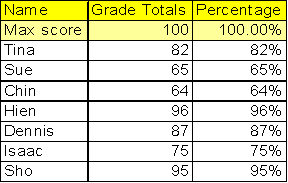
Figure 99
7. What
we just completed did not require that we know anything about the four
different cell references. However, what we did was inefficient. There is a way
to create all those formulas by just creating one formula in cell C2 and then
copying it down through our range. We will have to learn how to “LOCK” or make
“ABSOLUTE” some of our cell references. If we can learn how to do this, it will
make tasks such as this easier to complete and will result in few errors. In
addition, many of the most advanced Excel Features and tricks are only possible
if we learn about these four cell references.
8. Highlight
the range C2:C9 and then hit the delete key (Keyboard short cut: Delete key = delete cell
content but not format) (Figure 100):

Figure 100
9. Click
in cell C2 and create the following formula (Figure 101):

Figure 101
10. Now think
about this: the numerator B2 needs to always look one cell to my left and the
denominator B2 always needs to be locked on B2. We have to let Excel know that
the two B2s are different. (If you don’t remember the difference between
numerator and denominator use Google’s definition feature to look these words
up).
the
numerator B2 needs to always look one cell to my left
i.
This is called a relative cell reference
ii.
Relative to the cell the formula sits in, the cell reference
always needs to look one cell to the left
iii.
For our example the “one-to-the-left” B2 will be
entered into the formula as B2
the
denominator B2 always needs to be locked on B2
i.
This is called a LOCKED or ABSOLUTE cell reference
ii.
The secret code we need to put into our cell reference
to let Excel know that the cell is locked in the “$” sign. Why the dollar sign?
No reason – just think of it as the secret code).
iii.
But where do we put the secret code? The answer depends
on which direction you will be copying the formula. In our case we will be
copying up-and-down, across the rows (and rows are numbers), so the secret code
goes in front of the Number 5
iv.
For our example the “LOCKED” B2 will be entered into
the formula as B$2
11. Very
carefully, place your cursor in the middle of the denominator B2 and click the
F4 key twice (Figure 102):

Figure 102
12. Hold Ctrl,
then tap Enter. You should see this (Figure 103):

Figure 103
13. Point to
the fill handle and with your angry rabbit copy the formula down to cell C9 (Figure
104):

Figure 104
14. Notice that
it copied the yellow cell fill-color formatting down with the formula. Take you
cursor and click on the blue smart tag, then click on Fill Without Formatting
(this great feature copies only the formula) (Figure 105):

Figure 105
15. Click in
cell C9 and audit the formula to make sure that you actuality did create 8
formulas, but only had to create one formula which you then copied down (Figure
106):

Figure 106
16. Click in
cell G2 and create the formula seen in Figure 107.
Because the January 1000 amount will be increased by 10% each month, we need to
multiply (1 + .10) or 1.10 by each previous month’s amount. But notice that the
cell reference F2 is actually always going to be looking at the cell “one-to-the-left”
(relative cell reference = F2) and the cell reference F4 will always be
“locked” on F4 when copying it side-to-side, across the columns (columns are letters),
so the secret code goes in front of the letter (locked copying it across the
columns = $F4)

Figure 107
17. Very
carefully, place your cursor in the middle of the F4 and click the F4 key three
times (Figure 108):

Figure 108
18. Hit Ctrl +
Enter. Point to the fill handle and copy to formula to J2 (Figure 109):

Figure 109
19. Click in
cell J2 to audit the formula with the F2 key (Figure 110):

Figure 110
20. Look in Figure
111 at the table titled “What will your
Pension be worth when you retire?” We would like to estimate what our pension
will be depending on the annual rate that we earn and how many years we save
for retirement. The trick here is that we don’t want to type 54 formulas. We
would like to create the whole “sea of formulas”, G13 to L21, by creating only
one formula in cell G13 and then copying it to the remaining cells.
21. Click in
cell G13 and type “=FV(“. The screen tip will come up to help you with the arguments
for this function. To calculate our retirement funds we will need to assume an
annual rate “rate”, the number of
years that we deposit money “nper”
and a yearly deposit amount “pmt” (Figure
111):

Figure 111
22. Click on cell
G12 (Figure 112):

Figure 112
23. Can you see
in Figure 112 that we will need to use
the 10% for all the formulas in column G? Can you also see that when we copy
the formula over to column H we need to use the 11%? This means that we need
the cell reference locked (absolute) when we are copying the formula down, or
vertically, or across the rows: the row reference needs to be locked! However,
when we copy the formula to column H the cell reference should not be
locked (absolute) when we are copying
the formula to the side, or horizontally, or across the columns. The column
reference is not locked: it is relative.
24. Because we
want to lock (absolute) this cell reference when we copy the formula down, across
the rows, we need the “$” sign in front of the number. Because we want this
cell reference to move relatively as we copy the formula to the side, across
the columns, we do not need the “$” sign in front of the letter. Cell reference
= G$12 è
hit F4 twice (Figure 113):

Figure 113
25. Type a
comma, click on F13, and hit F4 three times.
26. We hit F4
three times because we want this cell reference to move relatively as we copy
the formula down, across the rows, and we want the cell reference locked
(absolute) as we copy the formula to the side, across the columns. Cell
reference = $F13 è
(Figure 114):

Figure 114
27. Type a
comma, type a minus sign, click on cell F23, and hit F4 once, type a close
parenthesis.
28. Because we
want to use the cell reference F23 in every cell when we copy this formula, we
want the cell reference locked in all directions. The dollar sign in front of
the column reference “F” locks the cell reference when copying the formula to
the side, across the columns. The dollar sign in front of the row reference “23” locks the cell reference
when copying the formula down, across the rows. Cell reference = $F$23 è
(Figure 115):

Figure 115
29. Hold Ctrl, and
then tap Enter. Point to the fill handle and click and drag formula down to
cell G21 (Figure 116):

Figure 116
30. Don’t be
alarmed by the pound signs. They are just saying: “Please expand the column so
this big number has room to show itself.” Point between the two column headings
G and H and double click to expand the columns. You should see this (Figure 117):

Figure 117
31. Now point
to the fill handle in the lower right corner for the entire range, then click
and drag to L21. Notice that many pound signs appear. Highlight the column
headings from H to L by clicking on the columns heading H and dragging to L.
Then double-click between the column headings H and I to expand the columns (Figure
118):

Figure 118
32. Our result
is that 54 formulas were created by enter just one formula, adding the correct
cell references and then copying the formula in two-steps (first down, then
over) (Figure 119):

Figure 119
33. For more
practice with cell references, click on the sheet tab named “Multiplication
Table and see if you can create 144 formulas by enter just one formula, adding
the correct cell references and then copying the formula in two-steps.
In the last few examples we saw what
happens to cell references when we copy a formula that has cell references. Now
we need to see what happens when we move a formula that contains cell
references. Copy means copy the formula from a cell or range of cells, leave
the formula in the original location, and then paste the formula in some other location.
Move means cut the formula from a cell or range of cells, it will no longer be
located in the original location, and then paste the formula in some other location.
Here are the steps to
learn about the difference between copying and moving a formula with cell
references.
1. Click
on the sheet tab named “Copy and Move.” Click in cell B6 and follow the
instructions listed in cell B5 (Figure 120Error!
Reference source not found.):

Figure 120
2. Figure
121, Figure 122 and Figure 123 illustrate
that when you copy a cell reference that has a relative cell reference component,
the cell reference changes relatively. In Figure 121 we see a formula that is looking into cell B1. In Figure 123 we see a formula that is looking into cell
B3. When we copied the formula, the cell reference moved relatively – it
actually did exactly what we told it to do, namely, “always look five above”.

Figure 121

Figure 122

Figure 123
3. Now
let’s look at what happens when we cut a formula with a relative cell reference
and paste it somewhere else.
4. Click
in cell D6 and create the formula “=B3” (Figure 124):

Figure 124
5. Hold
Ctrl, then tap Enter (Figure 125):

Figure 125
6. Ctrl
+ X, hit Tab (Figure 126):

Figure 126
7. Ctrl
+ V (Figure 127):

Figure 127
8. Hit
F2 (Figure 128Figure 127):

Figure 128
9. Compare
Figure 124 and Figure 128. When you cut a formula with a relative
cell reference component and paste it into a new cell, the formula does not
change – it actually moves the cell references exactly as they were in the
original cell and pastes them in the new location. This is because when you
move, you do not change anything; you simply put the formula, intact, in a new
location.
10. Wow!
Knowing the difference between moving and copying formulas is very helpful in
our pursuit of efficient spreadsheet construction. Let’s practice copying a
formula with relative cell references another time before we move on to the
next topic è
11. Navigate
back to the sheet tab named “The Equal Sign” by holding the Ctrl key, and then
tapping the PageUp key nine times (=SQRT(81) times in Excel speak). You should
see this (Figure 129):

Figure 129
12. Click in cell F2. Hit the F2 key (Figure 130). Look at
the formula in cell F2. Can you say what type of cell references they are? Can
you say what will happen to the formula when you copy it down from F2 to F6?
The formula in cell F2, “=B2-E2”, uses relative cell references and so when you
copy it down the cell references will move relatively. The formula actually
reads: “always look four to the left and subtract one to the left”.

Figure 130
13. Hold Ctrl,
then tap the Enter key. Point to the fill handle and with your cross hair
(angry rabbit), double click. The double click on the fill handle with your
angry rabbit (cross hair), tells the formula to copy down as long as there is
cell content in the cell directly to the left (Figure 131):

Figure 131
14. Click in
cell F6 and hit the F2 key (Figure 132).
Because the cell references are relative and because we copied the formula, the
formula, “=B6-E6”, looks different, but really it is the same formula, namely:
“always look four to the left and subtract one to the left”.

Figure 132
15. Look at Figure
132. What is the word “Assumptions”
across C8 and D8 mean?
16. Click the
Esc key to remove the range finder in cell F6. Click in cell C2 and then hit
the F2 key (Figure 133). We can see in
our formula that Deduction 1 is calculated by taking Suix Chin’s Gross Pay and
multiplying it by the tax rate of 6.20%. Because the tax rate of 6.20% can
change we have placed it in a cell and had our formula refer to it using a cell
reference. We have assumed that our tax rate is 6.20% and thus have placed it
into an assumption table. In our next section we will discuss the amazing power
of assumption tables: when to use them, what to put in them and how to properly
orientate them!

Figure 133
Our golden rule for assumption tables is: All data that can
vary (variable data) goes into a properly orientated assumption table. An
example of data that can vary is a tax rate. An example of that data that will
not vary is 12 months in a year. Remember: we don’t want to type data that can
very into a formula for three reasons: 1) It is easier to edit or change our
formula later if the variable data it is not typed into the formula (example: tax
rate changes), 2) It is more polite for the spreadsheet user if the variable
data can be seen on the face of the spreadsheet. (For example, even if we were
to create a formula with variable data typed into the formula (such as
“=$B2*.062”), when we came back tomorrow to use the worksheet, we as the
creator might not even remember which formulas have variable data and/or what
the variable data is). 3) what-if or scenario analysis is significantly easier
when an assumption table is used. What-if/scenario analysis is simply when you
change the variables to see different results.
In addition to the easy with which we can edit or locate
variable data, assumption tables that are properly orientated can reduce the
number of formula that we will be required to type into our spreadsheet. Proper
orientation means the labels in the main table are orientated (horizontally or
vertically) in the same way as the labels in the assumption table, and that
there is at least one blank row or column between the main table and the
assumption table. Also, you can format the assumption table differently to
distinguish it from the main table.
In this section about assumption tables we will learn:
1. When
to use them
2. What
to put in them
3. How
it is easier to locate and edit variable data
4. How
to properly orientate them!
5. See
the ease with which we can conduct What-if/scenario analysis
6. Bask
in the amazing power of assumption tables!!
It will help if we work through an example è
Here are the steps to
learn about assumption tables:
1. Navigate
to the sheet tab named “Assumptions” (Figure 134).
This table will be used to calculate the Net take home pay for a number of
employees. Notice that the calculated amounts for Commission on Sales, and
Gross Pay have already been calculated. Our goal is to calculate the three
payroll deductions (FICA, Medicare, and simplified Federal) and the Net Pay.

Figure 134
2. Click
in cell C3 and hit the F2 key. We can see the formula “=B3*E$12” ( Figure 135). Our first question we want to answer is:
when do we use an assumption table? We use an assumption table when our formula
contains variable data such as a tax rate. In cell E3 we are calculating the
commission on sales that we pay each employee. Can this commission rate change?
You bet!

Figure 135
3. Hit
the Esc key. Click in cell E12. Our second question is: what do we put into an
assumption table? We put the variable data that we need for our formula into an
assumption table. In Figure 136 we can
see that the commission rate of 1.25%, which we used in our formula, has been
placed into an assumption table. This enables easy editing and formula updating
later. Now, imagine that the boss just gave everyone a raise from 1.25%
commission to 2% è

Figure 136
4. Our
third question is: How easy is it to locate and edit variable data? Very easy!
5. Type
2, then hit Enter (because the cell was preformatted with the percent style, we
did not have to type the % symbol). You should see the entire column of “Commission
on Sales changes (Figure 137). THAT WAS
EASY!! It is easier to change the variable data when it is on the face of the
spreadsheet that it is to look for it, hidden underneath, inside a formula! I
can already feel that vacation time adding up with all the time I will be
saving!

Figure 137
6. Click
in cell E12 and change the rate back to 1.25%. Our goal is still to calculate
the deductions and calculate take home pay
7. Click
in cell F3 and create the formula for calculating the FICA deduction. But wait!
Which assumption table should we use?
8. Is
the formula “=E3*F$16” (Figure 138) the
one to use?

Figure 138
9. Or
is the formula “=$E3*F$12” the one to use?

Figure 139
10. The answer
to which formula to use (which formula is more efficient) leads to the fourth
question: what is the proper orientation for our assumption table? If we were
to use the formula as seen in Figure 138,
“=E3*F$16” we would have to create three separate formulas to make all our
deduction calculations. If we were to use the formula as seen in Figure 139, “=$E3*F$12” we would have to create only
one formula to make all our deduction calculations. This sort of efficiency is
exactly what we are striving for. But why does the formula using the variable
data from the assumption table that is orientated horizontally allow us to
create only one formula that will work for all our deductions? To see this,
let’s try both formula and see which works best.
11. You should
still have cell F3 highlighted. Create this formula: “=E3*F$16” (Figure 140):

Figure 140
12. Hold Ctrl,
then tap Enter. Point to the fill handle, and with the Angry Rabbit cursor,
copy the formula down through the range
F3:F7. Then click in cell F7 and hit the F2 key (Figure 141). You can see that the formula worked when we copied it down.

Figure 141
13. Hit Esc. Click
back into cell F3. Copy the formula to cell G3. Click in cell G3 and hit the F2
key to show the Range Finder. In Figure 142
we can see that the range finder shows that the cell reference for our tax rate
moved and is now looking into the cell G16. Because the orientation of the
assumption table is vertical (the labels for FICA, Medicare and Federal are located
one on top of the other) and the orientation of our main table is horizontal,
we would have to create three individual formulas in the cells F3, G3 and H3.
Notice that in Figure 142 that the range
finder moved to the right when we copied our formula to the right. This
indicates that if we had used the horizontally orientated assumption table that
formula would have calculated correctly è

Figure 142
14. Click Esc.
Then Hold Ctrl, and tap the Z key three times (undo). Then create the formula “=$E3*F$12”
in cell F3 (Figure 143):

Figure 143
15. Hold Ctrl,
tap Enter. Ctrl + C (to copy formula). Hold Shift, then tap the Down Arrow key
4 times and the Right arrow key 2 times (highlights the range). Ctrl + V (pastes
formula). Click in cell H7 and hit the F2 key. In Figure 144 we can see that because we orientated our
assumption table correctly, it worked like MAGIC! We created the sea of
formulas in the range F3:H7, 15 formulas, but we only had to type in one formula!
This sort of efficiency is our goal!

Figure 144
16. Hit Esc.
Highlight the range F3:I8. Hold Alt, and then tap the Equal sign key “=” (Alt +
= is keyboard shortcut for AutoSum). As you can see in Figure 145, by highlighting a range of values and one
blank row below and to the right, the Auto Sum feature knew what to add up. It
doesn’t always add up the correct amount, so let’s check to be sure. After
selecting cells with the AutoSum and verifying, the last cell we will check is
cell I8 (Figure 145):

Figure 145
17. Highlight
the range J3:J8 (Figure 146). Notice that
when you highlight a range that one of the cells is white and the rest are a
light steel-blue color. The white cell is waiting for you to put a formula into
it. If you put a formula into cell J3 and then hold Ctrl and tap Enter, you
formula will go into all the cells highlighted è

Figure 146
18. Create the
formula that will always take the value “five to the left and then subtract one
to the left in cell J3. Type ‘=”, tap the left arrow key five times, Type “-“,
tap the Arrow key once. You should see this (Figure 147):

Figure 147
19. Hold Ctrl, and
then tap Enter. We see here that if you
have a range highlighted and you place a formula into the white cell, when you
hold Ctrl and tap Enter, the formula is placed into all the cells that are
highlighted! You should see this (Figure 148):

Figure 148
20. Our fifth
question is: How easy is what-if/scenario analysis when we use assumption
tables?
21. Click in
cell E12 and change the Commission rate to 2%. Click in cell H12 and change the
simplified Federal Withholding rate to 20%. Can you see how easy it is to say:
“What if I changed this; what would happen to our calculations and our
results?” (Figure 149):

Figure 149
22. is hidden
underneath, inside a formula
23. Our final
question about assumption tables is how can we bask in the amazing power of
assumption tables?
24. Imagine your
boss comes in and says: “we just added a new 2% deduction can you update our
calculating table?” You look over your shoulder and say: “Oh you mean like
this?!!” And with blistering speed you complete these steps è
25. Click in
column H, Click Alt, then tap I and then
tap C (Figure 150):

Figure 150
26. Click in
cell H11 and type Pension. Hit Enter, then type 2% (Figure 151):

Figure 151
27. Highlight
the range G2:G8 and point to the fill handle in the lower right-corner. When
you see your Angry Rabbit, click and drag one column to the right. You are
done! 10 clicks and you have completely updated the table and you have amazed
your boss (who then promptly gives you a promotion)! (Figure 152):

Figure 152
28. In Figure 152 we can see that the deduction formulas
updated because we used a properly orientated assumption table and mixed cell
references; we can see that the SUM function for totals in row 8 updated
because they were always looking to add the five above; and we can see that the
totals for Total Deduction updated when we inserted a column because it
utilized a range in its arguments! Wow, now we can have extra vacation time and
bask in the amazing promotion we received – all because of efficient use of
assumption tables, mixed cell references and range functions!
29. Highlight
the range K3:K8. Click the increase decimal button twice (Figure 153). Notice that the total Net Pay is $13,762.64.

Figure 153
30. Click in
cell K8 and then hit the F2 key (Figure 154).
There is no way that $19,563 - $5,800 = $13,762.64. What is going on here? This
is one of the most common mistakes that people make in Excel. It is our job as
Soon-To-Be Excel Efficiency Experts (EEE), to know that this is caused by
formatting. What we often see in Excel is not actually what sits in the cell. 
Figure 154
31. To prove to
ourselves that what is in the cell is different than what we are seeing on the
surface of the spreadsheet, highlight the range B3:K8 and click the increase
decimal button twice (Figure 155). We can
see that what was really in the cell was numbers with more decimal places than
we were allowed to see!

Figure 155
32. As you learn to work with Excel you must be
vigilant in the endeavor to always match the proper formatting with what
actually sits in the cell. This leads us to our next section about
formatting.
We format cells with color, number
formats (such as currency), borders and other format so that we can better
articulate our message to the viewer of our spreadsheet or printout of the
spreadsheet. For example in Figure 156 we
can see that formatting can help to communicate important information:
1. The
percentage format helps to communicate the number of parts for every 100 parts
2. The
accounting (similar to currency) format indicates that the Revenues, Expenses
and Net Income are in USA
dollars
3. The
double line under the Net Income communicates that this is the “bottom line”.
4. The
color helps to communicate that there are labels indicating what the numbers
mean

Figure 156
Here are the steps to
learn how to apply cell formatting
1. Navigate
to the sheet named “Formatting (2)”. Click in cell E2. Hold Ctrl, then tap the “*” key on the number
pad (this selects the table) (Figure
157):

Figure 157
2. Click
the All Borders button on the Formatting Toolbar ():

Figure 158
Figure 159
3. Highlight
the range A1:E1. Hold Ctrl key and tap “1” key (use the “1” below the F1 key not the “1” on the number pad). Ctrl + 1 opens the Format Cells dialog box
(you could also right-click the highlighted range and point to Format Cells) Once
you have the Format cells dialog box open click on the Alignment tab. See (Figure
160):

Figure 160
4. With
the Alignment tab selected, click the down arrow under Horizontal and
select “Center Across Selection” (Figure 161):

Figure 161
5. We
chose “Center Across Selection” instead of the more widely used “Merge and
Center”. “Center Across Selection” allows move universal structural changes
such as inserting columns/rows and moving, whereas the “Merge and Center”
sometimes will disallow such actions.
6. Click
the Font tab. Select “Poor Richard” font (or some other font), Bold style, Size
= 14, Color (of font) = White (Figure 162):

Figure 162
7. Click
on the Patterns tab and select Blue (Figure 163):

Figure 163
8. Click
OK (Figure 164):

Figure 164
9. Highlight
the rangeB2:E2, Hold Ctrl, Highlight A3:A6. Click the yellow “Fill color button
on the formatting toolbar (Figure 165):

Figure 165
10. Highlight
the range B3:E6 (Figure 166)

Figure 166
11. Hold Ctrl
and tap 1. Point to the Number tab. Select Accounting with no dollar sign,
click OK (Figure 167):

Figure 167
12. Highlight
A6:E6, Ctrl + 1, click the Borders tab. In the Line/Styles box, click the
medium thick line (second column, fifth down) (Figure 168):

Figure 168
13. Click
the down arrow under color and select a color (Figure 169):

Figure 169
Figure 170
14. Click the
top line in the Border area (Figure 171):


Figure 171
15. The most
important method that you must memorize to get this tab to work is this: ORDER
MATTERS – you must click Line/Style FIRST, Color SECOND, and then draw your
line the Border area THIRD!
16. Now, use
the method just discussed to add a Navy Blue Double line to the bottom border
of our highlighted range (1):


Figure 172
17. Click OK,
You should see (Figure 173):

Figure 173
18. Now that we
have seen how to apply formatting, we need to look at how formatting can
sometimes trick us. If we are to because efficient with Excel we need to be
able match the proper formatting with
what actually sits in the cell!
Cell Formatting is the façade that sits on top of data and
formulas. What you see is not always what sits in the cell. For example:
1. If
you see 3.00%, Excel more than likely sees 0.03
2. If
you see $56.70, Excel may see 56.695
3. If
you see 07/26/2005, Excel more than likely sees 38559
4. If
you see 9:30 AM, Excel more than likely sees 0.395833333333333
Let’s look at an example è
Here are the steps to
learn how to distinguish between formatting and actual cell content!!!!
19. Navigate to
the sheet named “Formatting (3)”. You should see what is in (Figure 174). Read the labels in column A and type in
the number in column B. Column C tells you what is actually in the cell. The
key strokes for typing the numbers in are as follows:
i.
B2 è 1, 3, :, 3, 9, Ctrl + Enter (that is to say: Type
the number one, the number three, a colon, the number three, the number nine,
and then hold Ctrl and then tap Enter)
1. Each
time you hit Ctrl + Enter, look at what you see in the cell and compare that to
what you see in the formula bar
ii.
B3 è 1, 0, /, 2, 5, /, 2, 0, 0, 5, Ctrl + Enter
iii.
B4 è 1, 0, Ctrl + Enter (Notice that you did not have to
type in the dollar sign – the cell is preformatted)
iv.
B5 è 1, 0, Ctrl + Enter
v.
B6 è 3, Ctrl + Enter
vi.
B7 è 768, Ctrl + Enter
vii.
B8 è 768, Ctrl + Enter

Figure 174
20. When you
are done you should see this (Figure 175):

Figure 175
21. Hold Ctrl
and tap ~ key (Figure 176)

Figure 176
22. What you
see in Figure 175 is the façade. What you
see in Figure 176 is what actually is in
the cell and is what Excel will use for any formulas (whether calculating, text
or other formulas)
23. Ctrl + ~ to
remove formula view. Then click on each cell in column B and using the Format
Cells dialog box look at what Number format each cell is using
i.
For Example in Figure 177
you can see that B2 has a time format

Figure 177
ii.
In Figure 178 you
can see the custom format (discussed in another book):

Figure 178
Rule #19: Cell Formatting is the façade that sits on top of
data and formulas. What you see is not always what sits in the cell.
The next page reminds you that there are six tabs in the
Formatting Cells dialog box. Two pages ahead we have an example of the
formatting façade getting in the way of accurate calculations!
Make a note that there are six tabs in the Format Cells
dialog box as seen below (Figure 179):






Figure 179
Here are the steps to
learn how to use the ROUND Function in Excel to insure accurate payroll
calculations when rounding to the penny is required
1)
Navigate to the sheet named “Round for Deduction”.
Before you make any calculations on this sheet, follow the calculations in step
2 and make the deduction calculations by hand with a pencil.
2)
How to use a formula to calculate a tax deduction
1.
Figure 180 shows
the Taxable earnings and short description of how to calculate a deduction. Use
Figure 181 to make a calculation by hand
using a pencil, an eraser and the rules of rounding to a penny!

Figure 180
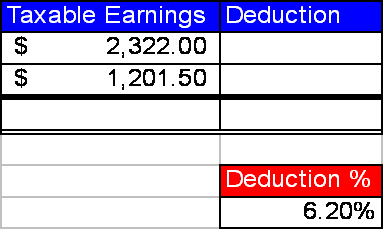
Figure 181
3)
Now we can try it in Excel
4)
How to use a formula to calculate a tax deduction
1.
Before we create a formula to calculate the deduction,
let’s look at the Accounting Number format already applied in the cell range
B2:B4. Highlight the range and hold the Ctrl key, then tap the 1 key. You will
see the Format Cells dialog box (Figure 182):
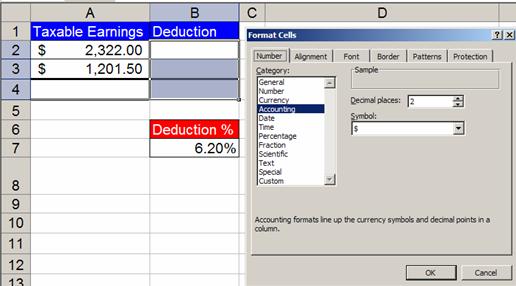
Figure 182
2.
To begin a formula, type the equal sign (Figure 183):

Figure 183
3.
With the thick white cross cursor, click on cell A2
(The cell reference A2 will appear in the formula) (Figure 184):
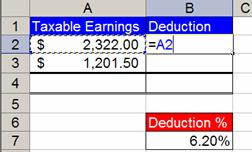
Figure 184
4.
Type the multiplication symbol (Figure 185):

Figure 185
5.
Click on the cell with the deduction % as seen below (Figure
186):

Figure 186
6.
Click the F4 key twice to lock the percent (Figure 187):
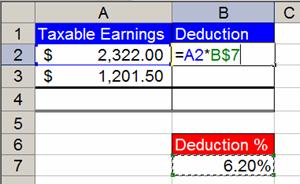
Figure 187
7.
Hold the Ctrl key, then tap the Enter key to place the
formula in the cell (Notice that you can still see the formula in the formula
bar (Figure 188):
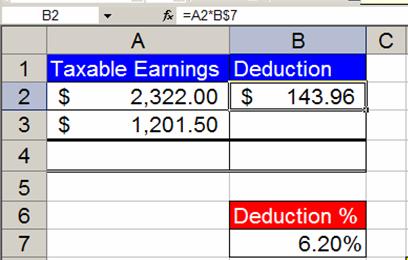
Figure 188
8.
Point to the fill handle (Little black box in lower
right corner of highlighted cell) (Figure 189):


Figure 189
9.
With fill handle selected, copy formula from B2 to B3 (Figure
190):

Figure 190
10. In
cell B4 add a SUM function by holding the Alt key and tapping the equal sign.
Verify that the SUM function selected the correct cells (Figure 191):
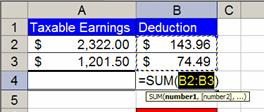
Figure 191
11. Hold
Ctrl and tap Enter (Figure 192):
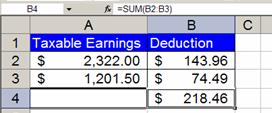
Figure 192
12. Go
down to the area with the yellow instructions and verify that you entered the
correct formula to calculate your payroll deductions. In cells E9 and E10 type
what you see in cells B2 and B3, respectively (DO NOT USE CELL REFERENCES). Create
a SUM function in cell E11 that adds the two cells above. (Figure 193):

Figure 193
13. Question:
What is the problem here???!!?
14. Answer:
Excel did its part perfectly, but we did not! We forgot to make sure that the
formatting and the calculating formulas are doing the same thing! To see how
these are different, select the cell range B2:B4 and use the increase decimal
button on the formatting toolbar to look at how the Accounting Number format
formats the cells. You should see this after you click the increase decimal
button once (Figure 194):

Figure 194
15. What
has happened here? The formulas underneath have calculated without rounding,
but the formatting on top has made it appear as if it has been rounded. The SUM
function does not look at formatted numbers, but instead looks at the calculated
unrounded numbers.
16. The
solution is to make the format and the calculated numbers exactly the same by
using the ROUND function.
17. Click
the Decrease Decimal button to restore the format. You should see this (Figure 195):

Figure 195
18. Add
a ROUND function to our formula by clicking in cell B2. To edit the formula
click the F2 keyboard button. You will see this (Figure 196):

Figure 196
19. With
your cursor point in between the equal sign and the letter “A” and click to
insert your cursor into the formula. Then type the letters and characters
“ROUND(“ as seen here (Figure 197):

Figure 197
20. Then
point your cursor to the formula bar and click at the end of the formula as
seen here (Figure 198):
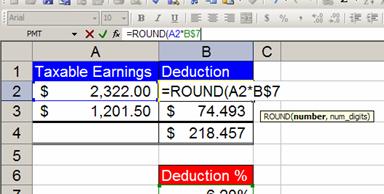
Figure 198
21. Type
the characters and numbers: “,2)” as seen here (Figure 199):
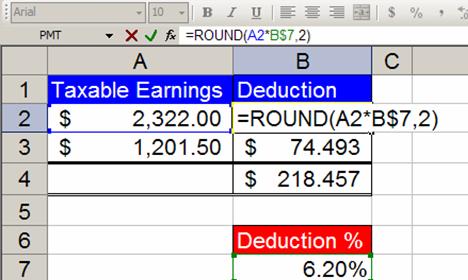
Figure 199
22. Hold
the Ctrl key and then tap the Enter key. Then copy the formula to cell B3. Now
you are done and you should see this (Figure 200):

Figure 200
5)
Conclusions: because formatting (such as currency)
is like a façade that sits on top of the number, when you have a formula that
has the potential to yield more decimal places than the format displays, use
the ROUND function.
1.
For a payroll calculation that must be rounded to the
penny, instead of =A2*B$7, use =ROUND(A2*B$7,2); where the second argument “2” means round to the second
decimal.
2 means round to the penny (Payroll)
0 means round to the dollar (Income Taxes)
-3 means round to the thousands position. (Financial
Statements)
Rule #20:
Because formatting (such as currency) is like a façade that sits on top of the
number, when you have a formula that has the potential to yield more decimal
places than the format displays, use the ROUND function.
Next we will look at how to work with Date formatting.
With Date format, Excel sees the
number of days since January 1, 1900 (inclusive). For example: January 1, 1900 is
represented by the serial number 1; January 2, 1900 is represented by the
serial number 2; and April 23, 2006 is represented by the serial number 38,830.
Here are the steps to
learn how to understand the Date format and to make date calculations (Excel
date math)
1. Navigate
to the sheet named “Date Math”. You should see this (Figure 201):

Figure 201
2. Hold
Ctrl and tap on the ~ key (this reveals what is actually in the cell; this is
called formula view). You should see what is in Figure 202. Understanding the Date format requires that you know that when
you type “4/23/2006” (Figure 201), Excel
sees 38830 (Figure 202). The “4/23/2006”
is the façade that we see. The 38830 is the serial number that Excel sees. This
serial number is very useful for making date calculations…

Figure 202
3. Hold
Ctrl and tap on the ~ key to remove formula view
4. Select
cell B2, Hold Ctrl and tap ; (semi colon)
to put Today’s date in the cell (Figure 203).
(Don’t worry if your day is different).

Figure 203
5. Select
cell B3, enter the formula “=B2-B3”, then hold Ctrl and tap Enter (Figure 204):

Figure 204
6. What
is going on here? Why is there a date in our cell instead of the number of days
the invoice is past due? The answer is this: When you create a formula it
brings the format from the cells that you have referenced to the cell you are
creating a formula within.
7. To bring the format back to the “General
format, Hold Ctrl and Shift and tap ~ (Figure 205):

Figure 205
8. Figure
205 reveals the beauty of the serial
numbers that lie behind every date: it is easy to do date math! Whether you are
calculating an overdue invoice, your own age, or an estimate of the number of
days to complete a job, date math is amazing!
9. One
final note about Date format: Click in cell D1 and type the number 38830, then
hold Ctrl and tap Enter (Figure 206):

Figure 206
10. Hold Ctrl
and tap 1, click on the Number tab, click on Date (Figure 207):

Figure 207
11. Click OK. Figure
208 illustrates directly that the number
38830 has a façade on top of it for us Excel users to see. In this way, we
understand that it is a date when we see it, but hidden underneath, Excel sees
the serial number so it can make date calculations!

Figure 208
12. For
everyday Excel use, you can enter dates such as 4/23/2006, by typing the
numbers and forward slashes – Excel automatically enters the serial number
behind the scenes.
Rule #21: With
Date format, Excel sees the number of days since January 1, 1900 (inclusive).
This allows us to make date math calculations.
Now that we have studied the Date format façade and how to
use it, we can look at the Time format façade and how to use it.
With Time format, Excel sees the
proportion of one 24 hour day. For example: 8:00AM is represented by the
decimal number (also known as serial number or time value) 0.333333333333333;
6:21AM is represented by the decimal number .264583333333333; and 5:15:15 PM is
represented by the decimal number .718923611111111.
Here are the steps to
learn how to understand the Time format and how to make time calculations
(Excel time math)
1. Navigate
to the sheet named “Time Formatting (1)”. You should see this (Figure 209):

Figure 209
2. When
entering times into Excl, you can use the following conventions (Figure 210):
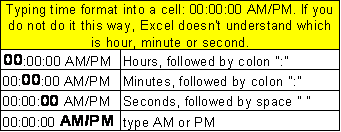
Figure 210
3. Click
in cell A1 and type: 8, :, 0, 0, (space), A, M (said another way: type 8:00 AM).
Click in cell B1 and type 6:21 AM. Click in cell C1 and type 5:15:15 PM (Figure
211).

Figure 211
4. Hold
Ctrl and then tap ~ to see what Excel sees (Figure 212):

Figure 212
5. In
Figure 212, notice that the decimal
number that represents 5:15:15 PM is greater than the decimal value that
represents 8:00 AM. This insight will allow us to subtract the earlier time
from the later time and get the proportion of one day that has elapsed between
the two times.
6. Hold
Ctrl and then tap ~ to return to our normal view. In order to see that 8 hours
does represent .333 or 1/3 of a 24 hour day, click in cell D3 and type the
formula “two cells above divided by one cell above” (Figure 213):

Figure 213
7. Hold
Ctrl and then tap enter. Point to the fill handle and drag the formula from
cell D3 through F3 (Figure 214):

Figure 214
8. Highlight
the cells D3:E3, hold Ctrl and then tap 1, click on the number tab, click on
the Time category (Figure 215):

Figure 215
9. Click
OK. In Figure 216, we can see that 8/24
or 1/3 is .333333333333333, but when we apply a Time format, the Excel user
sees 8:00 AM.

Figure 216
10. As an extra
bonus, click in cell F3 and apply the Fraction format. After you apply this
format you should see this (Figure 217):

Figure 217
11. With our
new understanding of the Time format, we would like to make some time
calculations in Excel.
12. Navigate to
the sheet tab named “Time Formatting (2)” You should see this (Figure 218):

Figure 218
13. We would
like to use Excel to keep track of employees work hours and gross pay. Click in
cell E2 and subtract the earlier time from the later time (“one to my left
minus two to my left”) (Figure 219):

Figure 219
14. Hold Ctrl
and then tap Enter (Figure 220). We see
is Figure 220 that the Time format has
carried forward into our cell with the formula.

Figure 220
15. Hold Ctrl
and Shift and tap ~. In Figure 221 we see
the proportion of the day that Luke ahs worked.

Figure 221
16. Hold Ctrl
and tap 1, select the Number tab, click on the Time category, click on the
second time type in the list (Figure 222):
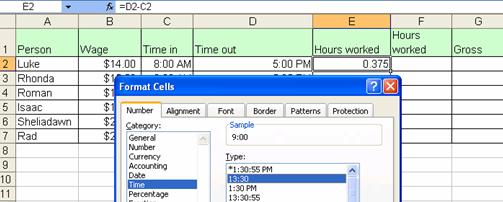
Figure 222
17. Click in G2
and type the formula as seen in Figure 223:

Figure 223
18. Hold Ctrl
and tap Enter. What is wrong with Figure 224?
Nothing! If WE were trying to multiply 9 hours times $14.00, we did not
accomplish this. We made the wrong calculation. Excel did not make the wrong
calculation. The resultant answer, 5.25, is exactly what we asked Excel to
calculate, namely: 375*14.

Figure 224
19. Delete the
contents of cell G2. In cell F2 type the formula “=(D2-C2)*24” (Figure 225). Notice that we had to know our order of
operations (the subtraction is in parenthesis) and we had to know that 24 is a
number that will not vary (thus it is OK to type into our formula).

Figure 225
20. Hit Tab.
Type the formula “one to my left times four to my left” in cell G2, and then
hold Ctrl and tap Enter. Then Hold Ctrl
and Shift and tap the $ key (this is the keyboard shortcut for the Currency
format). You should see this (Figure 226):

Figure 226
21. Highlight
the range E2:G2, point to the fill handle and with your angry rabbit, double
click the fill handle to copy the formulas down (Figure 227):

Figure 227
22. With our
knowledge of the Time format, order of operations and non-varying numbers, we
have created formulas that we can use for timesheet calculations.
Rule #22: With
Time format, Excel sees the proportion of one 24 hour day. This allows us to
make time math calculations.
Next
we will turn our attention to Excel’s Charting capabilities.
Charts
Charts and graphs are a means to visually articulation
numerical data. There are times when a picture (chart or graph) tells a
thousand words, or in our case, a thousand numbers. Charts and graphs can
deliver a message in a more immediate way. Although a chart or graph lacks the
detail of al the numbers, it quickly articulates its message in an effective
way.
In Excel, you use the Chart Wizard to create your
chart/graph. After highlighting your numerical data and labels, you click the
Chart Wizard button on the Standard toolbar, or select “Charts…” from the
Insert menu. There are many charts to choose from and choosing the correct one
can sometimes be tricky. We will look at four chart types: Pie chart, Column chart
with multiple series data, Column chart set up as a Histogram, and a XY
(Scatter)/Line chart. If you would like to learn about more of the built in
chart types, Click F1 (Microsoft Help) and type “chart types”. There is an
article that will lead to the website: http://office.microsoft.com/en-us/assistance/HA010346071033.aspx..
There are four steps to the Charts Wizard. We will look at each step as we create
our four different Charts:
Here are the steps for
creating a Pie Chart
1. Navigate
to the sheet named “Charts (1)”. You should see this (Figure 228):

Figure 228
2. Highlight
the range A3:A5, Hold Ctrl, Select the range E3:E5, and then click the Chart
Wizard button on the Standard toolbar (Figure 229).
Figure 230 on the next page shows the
dialog box that pops up.

Figure 229
3. Chart
Wizard Step 1 = Chart Type è What type of chart do you want? Notice in Figure 230
that by default the column chart is selected.
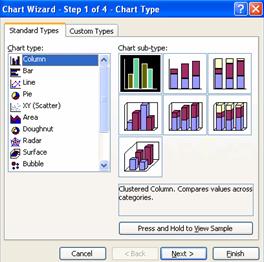
Figure 230
4. You
must memorize the 4 steps in the Chart Wizard. (In this way if you want to
change a part of your chart, you already quickly know which step to access and
change.)
5. For
our current chart we want a pie chart. Pie charts show the relationship of the
parts to the whole. You will often see the words “proportion” or “percentage”.
When you are required to make a pie chart. Figure 231 shows that data we are
using for our pie chart. Notice that we never highlight the total: we only
highlight the parts that make up the total.

Figure 231
6.
In Step 1 of the
Chart Wizard under Chart type, click on Pie (Figure 232). Notice the succinct description of what a pie chart is in the
lower right hand corner. Also notice that there is a button to “View Sample” of
your data with this chart.

Figure 232
7. Click
Next.
8. Chart
Wizard Step 2 = Source Data è Where is the source data located in the worksheet? (Figure
233). The Data Range
tab reveals the cells in the worksheet that the Chart Wizard is looking to in
order to make the chart. (Figure 233).
Because the Chart is looking at cells in the worksheet, when you change the
data in the cells, the chart will update!!
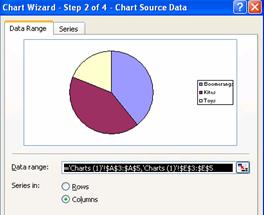
Figure 233
9. Click
on the Series tab. You will see this (Figure 234):
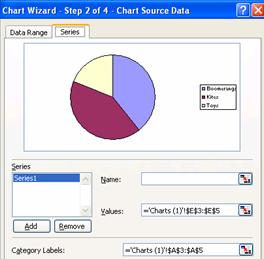
Figure 234
10. Chart
Wizard Step 2, Source Data, Series tab is perhaps the most important step while
setting up your chart. Because the chart wizard does not always place your
highlighted worksheet data into the correct parts of your chart, it is the
series tab that will let you redirect or refine how the data is displayed in
your chart. For our pie chart there is only one series. A series is simply a
set of numbers and category labels. In addition, we can see that the “Values”
are coming from the correct set of cells and our “Category Labels” are coming
from the correct set of cells. For a Pie Chart, the “Name” textbox will add a
title to our chart.
11. Click in
the “Name” textbox, then click in cell A1 in the worksheet, then hit the Tab
key. You should see this (Figure 235):

Figure 235
12. Click Next
13. Chart
Wizard Step 3 = Chart Options è What accessories would you like to add to your chart
(titles, axis labels, percentage indicators, etc.)? (Figure 236):
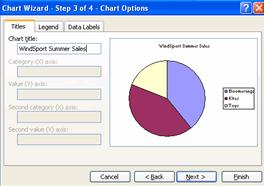
Figure 236
14. Click on
the Legend tab. Uncheck “Show legend”
15. Click on
the Data Labels tab. Check “Category name” and “Percentage”
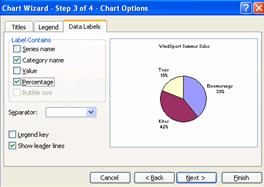
Figure 237
16. Click Next.
17. Chart
Wizard Step 4 = Chart Location è Do you want chart on top of worksheet, “As object
in’, or do you want the chart to be placed as its own new sheet, “As new sheet”?
(Figure 238)
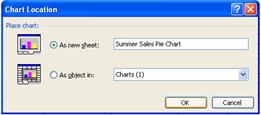
Figure 238
18. As seen in Figure
238, select the dialog button “As new
sheet”, click in the textbox for “As new sheet”, and type the chart sheet name:
“Summer Sales Pie Chart”
19. Click
Finish. You should see this (Figure 239):
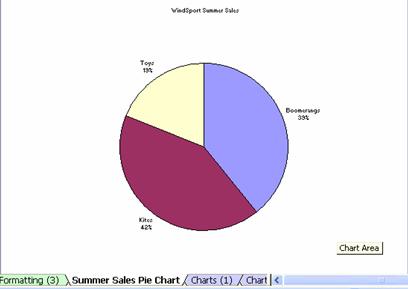
Figure 239
20. Once you
have created your chart, the # 1 rule for improving your visual message is:
“Everything is right-clickable”. Each part of your chart can be edited and
modifies by right-clicking that particular part.
21. Right-click
the title and point to “Format Chart Title” (Figure 240):

Figure 240
22. After you
click “Format Chart Title” and then click on the Font tab, select the settings
as seen in Figure 241. Click OK.

Figure 241
23. Click one
of the Category Names with Percentage labels. All three labels should be
selected as seen in Figure 242. After you
click on one label, you should see little black boxes on either side of each
label – this indicates that all the labels have been selected and any action
taken will apply to all labels.
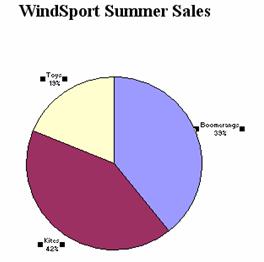
Figure 242
24. After
selecting all labels, right-click and point to Format Data Point (Figure 243):
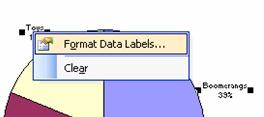
Figure 243
25. Click the Font
tab and select the items as seen in Figure 244
26. 
Figure 244
27. Click the
Number tab and select the items as seen in Figure 245:
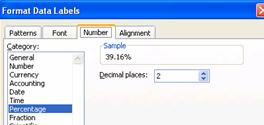
Figure 245
28. Click OK.
Then click one of the Category Names with Percentage labels (all three labels
should be selected), wait two seconds, then click the same label a second time
(this is called a S-L-O-W double-click). After this S-L-O-W double-click, only
one label is selected. (This S-L-O-W double-click is the key to highlighting
single data points that are part of a data series). The single selected label
should look like this (Figure 246):

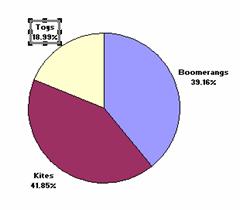
Figure 246
29. In
Figure 246 you can see the little black
boxes with a gray square around the label. To move this label, slide your
cursor close to the gray edge, and then click the gray edge to “grab” the
label. Then you can move the label further out from the pie piece. After you
have repeated the process for all the labels, you should see something like
this (Figure 247):
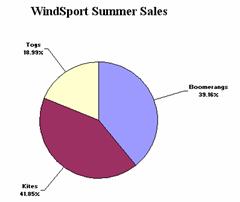
Figure 247
30. Using the
same S-L-O-W double-click technique, color each pie piece differently. Then
right-click the background and change its color. You may get a chart that looks
like this (Figure 248):

Figure 248
Here are the steps for
creating a Column Chart with multiple series
1. Navigate
to the sheet named “Charts (1)” and highlight the range A2:D4 (Figure 249):

Figure 249
2. Click
the “secret automatic chart creating” button: F11. You should see a chart
automatically created (as default chart type) and placed as a new sheet named
Chart1 (Figure 250):
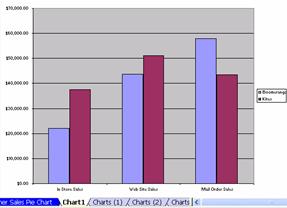
Figure 250
3. Right-click
the white area in the top-right corner and click on “Source Data” (Figure 251):
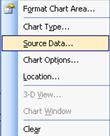
Figure 251
4. After
you click on “Source Data” you should see the tab for Step 2 of Chart Wizard (Figure
252). Notice the “multiple series”; there
are two series to be exact: Boomerangs and Kites. Below the list of series there
are buttons to “Remove” or “Add” series. In addition, you can see with multiple
series that the “Name” shows the cells that supply the data for the Legend (but
not chart title), the “Values” shows the cells that supply the data for the
values, and the “Category labels” shows the cells that supply the data for the
labels.
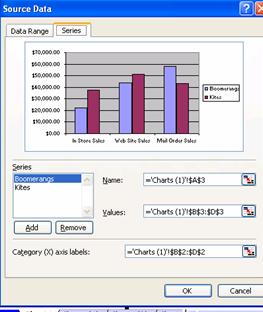
Figure 252
5. Click
OK. Right-click the white in the top-right corner and click on Location. You
should see the tab for Step 4 of the Chart Wizard. Click the dialog button next
to “As object in” and scroll down (you may have to scroll way down) and click
on the sheet tab name “Charts (1)”(Figure 253).
After you select the “Charts (1)” sheet, click OK.
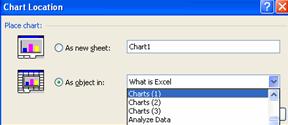
Figure 253
6. After
you click OK, the chart will be moved and placed as an object in the sheet
named “Charts (1)” (Figure 254):
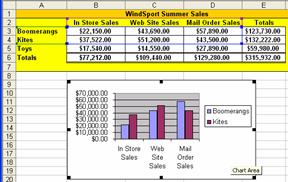
Figure 254
7. Highlight
the range A5:D5 and point to the edge of the highlight range (Figure 255):
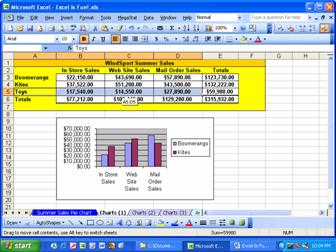
Figure 255
8. When
you see your “white-arrow with a thin four-way black-cross-arrow behind it”
cursor, click and drag the range onto the chart. (You are not moving the range;
you are actually dragging a new data series to the chart). You will know that
you have successfully clicked and dragged the range when you see the gray thick
border around the range. This gray border will move with your cursor as you
drag the range. When you drag your cursor to the chart area, the gray border
will surround the chart. At this point you let go of your mouse click and the
new data series drops onto the chart. (Figure 256):
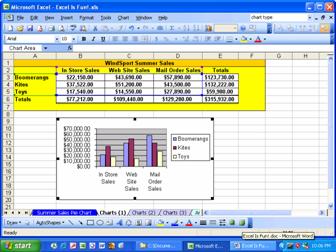
Figure 256
9. If
you want to change the default chart type, right-click any chart that has
already been completed and point to Chart Type (this trick will not work inside
Chart Wizard). After the Chart type dialog box appears there will be a button
you can click to set that chart as the default chart (default charts are what
gets created when you use the F11 key) (Figure 257):
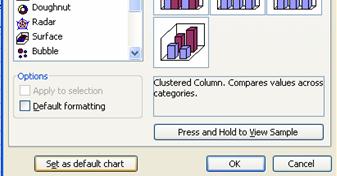
Figure 257
Here are the steps for
creating a Column chart set up as a Histogram
1. Navigate
to the sheet named “Charts (2)”. Highlight the range D3:E10. Click the Chart
Wizard button. In Step 1 of the Chart Wizard (Chart Type), accept the defaults
and click the next button. In Step 2 (Source Data), click the Series tab. You
should see this (Figure 258):
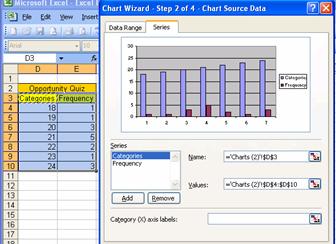
Figure 258
2. Figure
258 illustrates how Chart Wizard can
guess incorrectly. For our Histogram chart we need only one series and we will
need Category labels. With the Categories Series highlighted, click the remove
button. After the Category Series is removed, click in the Category (X) axis
labels textbox, then highlight the range D4:D10. And finally, click in the Name
textbox and then highlight cell D2. Your Series tab should look like this (Figure
259):
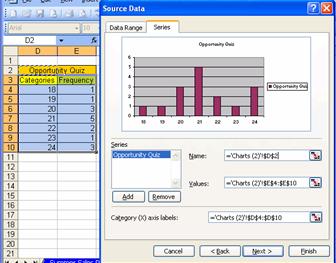
Figure 259
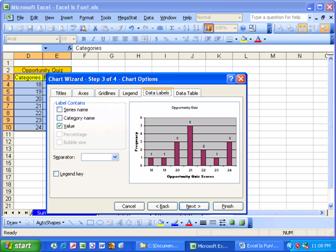
Figure 260
3. In
Figure 260 you can see that we have added
titles and labels using the Titles tab, we got rid of the legend using the
Legend tab, and we have added value labels using the Data Labels tab.
4. Because
we will place this chart as an object in this sheet, we don’t need to go
through Step 4 (the default setting will get us what we want), so click Finish.
You should see this chart:
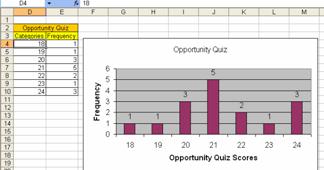
Figure 261
5. With
Histograms the columns should have no gaps between them. As a result we need to
right-click one column and Format The Data Series (Figure 262):
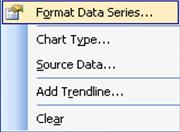
Figure 262
6.
Click on the Options tab and change the Gap width to
zero (Figure 263). Once you click OK,
your Histogram is completed.

Figure 263
Here are the steps for
creating a XY (Scatter) chart
1. Navigate
to the sheet tab named “Charts (3)” and highlight the range A1:B28 (Figure 264):
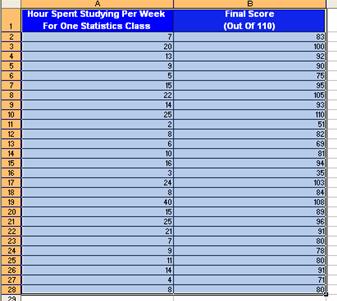
Figure 264
2. Click
the Chart Wizard button and in Step 1 under Chart type select “XY (Scatter)”.
Click Next. Click NEXT again to get to step 3. Remove the Legend using the
Legend tab. Click on the Titles tab and add the labels: X = “Hours Studying per
Week for Stats Class” and Y = “Score on Final” (Figure 265):
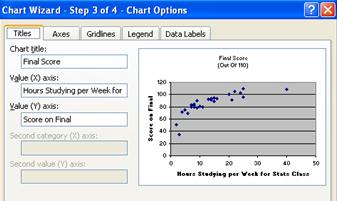
Figure 265
3. Click
Finish. You should see this chart (Figure 266):
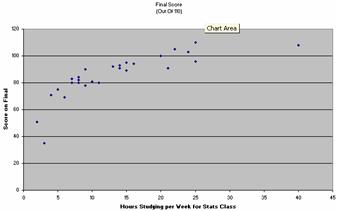
Figure 266
4. Right-click
one of the data points and click on “Add Trendline” (Figure 267):
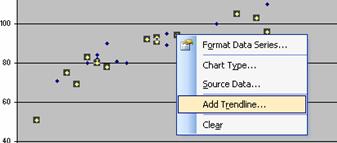
Figure 267
5. After
you click on Trendline, you should see this dialog box (Figure 268):

Figure 268
6. Click
on the Options tab and check “Display equation on chart” and “Display R-squared
value on chart” (Figure 269)
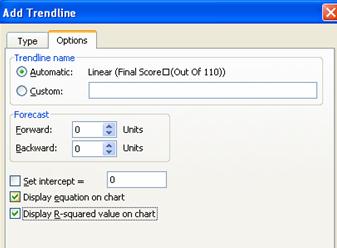
Figure 269
7. Click
OK. Figure 270 shows how easy creating
charts for liner algebra can be. Figure 270
also has a number of items changed by right-clicking and changing. The labels
and the equations have an increased font size and the vertical axis has the
minimum value changed to 60.
The essential beauty of Excel is that you can make
calculations and analyze/manipulate data quickly and easily “on the fly!”
What-if analysis is easy in Excel. You can Sort to see which Sales Rep had the greatest
sales, create Subtotals by Region, and do complex data analysis such as summarizing
on multiple criteria. (This section is only a brief look at Excel’s infinite
Analyzing capabilities…). For this section we will look at Sorting, automatic
Subtotals and a basic PivotTable.
The #1 MOST IMPORTANT THING TO REMEMBER WHEN YOU START TO
USE EXCEL’S DATA ANALYSIS TOOLS IS:
Rule #24: Before
you use Excel’s Data Analysis Tools: the data must be in proper Excel List
Format: 1) First row has field names with bold and other formatting that is
different from the rest of the data; 2) No blank field names; 3) Columns are
Fields; 4) Rows are records; 5) No blank columns (fields); 6) No blank rows
(records); 7) Blank rows and columns (or Excel’s column headers (A, B…) and row
headers (1, 2…) must separate the Excel List from other data
Columns are called “Fields”. Fields are the variable data
for each record. Rows are called “Records”. Records are individual collections
of the fields. For example, navigate to the sheet tab named “Analyze Data”. You
should see this (Figure 271):
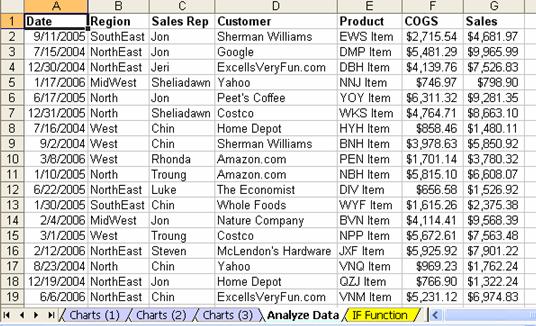
Figure 271
In Figure 271 we can
see:
1. Proper
Excel List Format
2. Each
row represents one Sales Transaction
i.
Each sales transaction is one new record
ii.
Each record is an individual collection of the seven
fields
3. The
first seven columns represent fields
i.
Each field is a variable
1. For
each new transaction it can have a different date or different region or
different sales rep
Steps to Sort to see which
Sales Rep had the greatest Sales
1. Click
in the Sales column. Click in only one cell in the sales column (if you
highlight more than one cell, you may sort just part of the data). Point to the
Sort Z è
A button on the Standard toolbar (Figure 272):
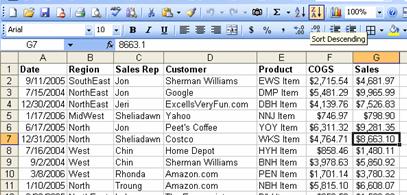
Figure 272
2. Click
the Sort button. Because our data is in Proper Excel List format, the entire
2000 row block of data is sorted by sales! (Figure 273):
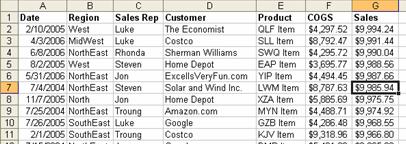
Figure 273
3. Click
in one cell in the Sales Rep field and then click the Sort A è
Z button on the Standard toolbar (Figure 274).
Notice that the prior sort was retained. We can see that the Sales Rep has the
Sales still sorted! Scroll down and see that all 2000 rows have been sorted!

Figure 274
Rule #25:
Before Sorting using the Sort button, make sure your block of data is in the
Proper Excel List Format and highlight only one cell in the field you want to
sort.
Steps to add automatic
Subtotals
1. Click
on the Data menu, and then click on Subtotals (Alt + D + B). You should see Subtotal
dialog box as seen in Figure 275. Notice
that the whole table was highlighted when you invoked the Subtotals dialog box
(this is because you have your data in Proper Excel List format). Using the
drop-down arrow for the “At each change in” textbox, select the Sales Rep
field. For the “Use function”, use the Sum function. For the “Add subtotals to:
checkboxes check the Sales field.
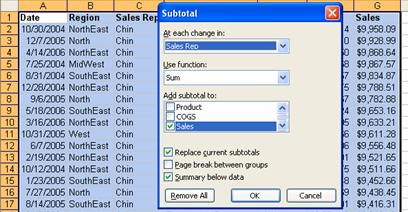
Figure 275
2. Click
OK. You should see something similar to Figure 276.
On the left of your screen you should see three little blue-gray boxes with the
numbers 1, 2, and 3 in
them. These are called Outline buttons.

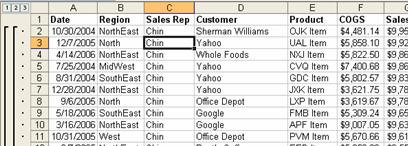
Figure 276
3. Click
the “2”
Outline button and you should see subtotals similar to those as seen in Figure 277. The plus and minus symbols are collapse
and expand symbols. You can use these to expose the data for a particular Sales
Rep. You can also use the “3”
Outline button to expose all the records.

Figure 277
4. To
get rid of Subtotals click tap Alt + D + B + R. Click in one cell the Region
column and click the Sort A è Z button. You should see this (Figure 278):
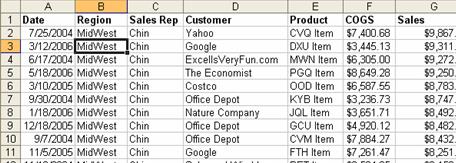
Figure 278
5. Now
we would like to create Subtotals by Region. Tap Alt + D + P and change the
Subtotal parameters to the ones as seen in Figure 279:
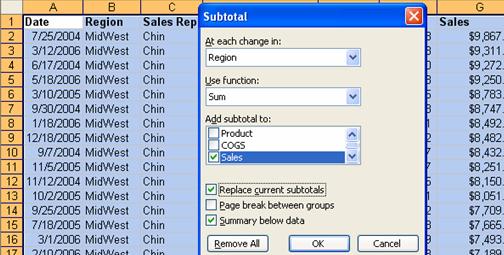
Figure 279
6. Click
OK. Click the “2”
collapse button and you should see this(Figure 280):

Figure 280
7. It
is possible to add another level of Subtotals. In order to add for the Sales
Reps within each Region, tap Alt + D + B to view the Subtotals dialog box (Figure
281). The key to adding another Subtotal
is to uncheck the “Replace current subtotals” check box, and be sure to change
the field for the “At each change in” to Sales Rep.
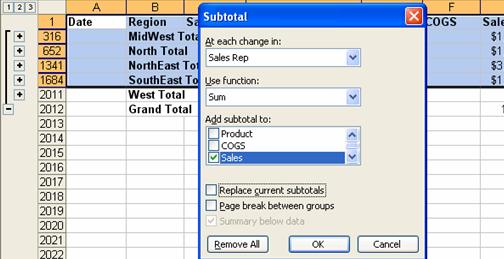
Figure 281
8. Click
OK. You should see this (Figure 282):
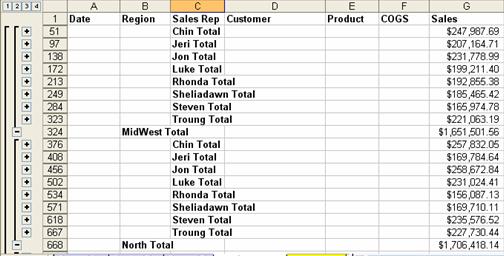
Figure 282
Rule #26:
Before adding automatic Subtotals, sort your field. If you want to add a
Subtotal to a Subtotal, Be sure to uncheck the “Replace current subtotals” check box.
9. To
get rid of your Subtotals, tap Alt + D + B + R + Enter.
Steps to create a basic
PivotTable
1. Make
sure you have one cell in your data block selected (Proper Excel List Format).
Point to the Data menu, click PivotTable and PivotChart Report (Figure 283):
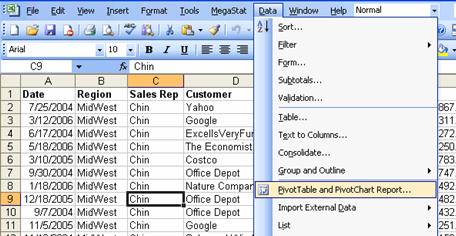
Figure 283
2. Step
1, click Next (Figure 284):
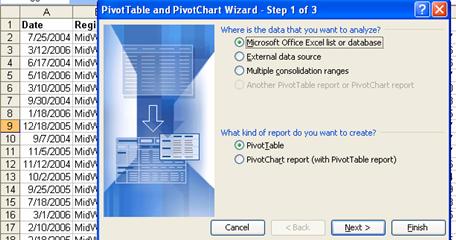
Figure 284
3. Step
2, make sure that the data range is selected and then click Next (Figure 285):
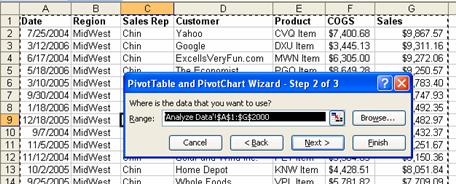
Figure 285
4. Step
3, click Finish (Figure 286):
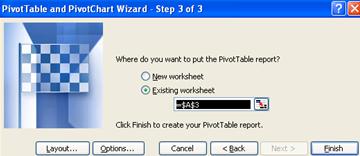
Figure 286
5. After
you click Finish you should see what is in Figure 287. The beauty of this is that you will use the Pivot Table Field
List to send Fields to the “Drop Row Fields Here” area, “Drop Column Fields
Here” or the “Drop Data Items Here” area. Don’t let this odd looking setup fool
you, it’s just a table with variables along the left side (rows) and top
(columns) with the intersection in the “Drop Data Items Here” area. So, if you
want to quickly show how much each Sales Rep had in Sales by each Region you
would just put the Sales Rep field in the “Drop Row Fields Here” area, Region
field in the “Drop Column Fields Here” area, and the Sales in the “Drop Data
Items Here” area.
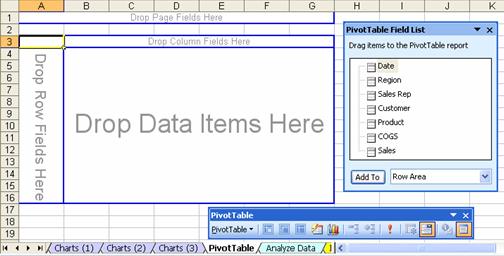
Figure 287
6. In
the Pivot Table Field List, select the Sales Rep field, next to the “Add To”
button click the down-arrow and select Row Area, then click the “Add To” button
(Figure 289):

Figure 288
Figure 289
7. In
the Pivot Table Field List, select the Region field, next to the “Add To”
button click the down-arrow and select Column Area, then click the “Add To”
button (Figure 290):
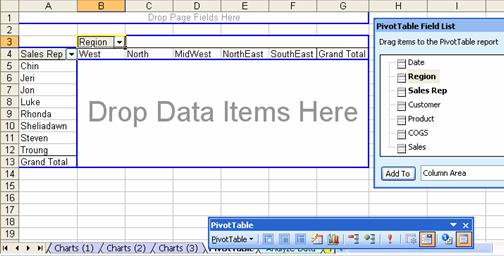
Figure 290
8. In
the Pivot Table Field List, select the Sales field, next to the “Add To” button
click the down-arrow and select Data Area, then click the “Add To” button (Figure
291):
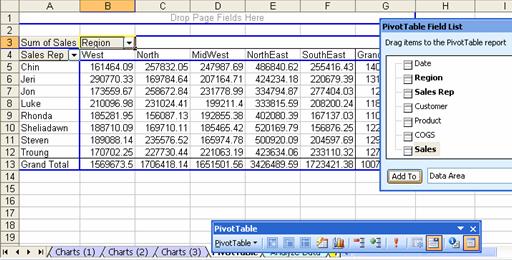
Figure 291
9. Think
about this: you just took 2000 rows of transactional data and within one
minute, you created this summary table!
10. PivotTables
are the most powerful feature in Excel. During another class or book we can
explore in great depth the magic of PivotTables…
Rule #27:
When your data is in Proper Excel List Format, PivotTables are the most
powerful tool in Excel. Don’t be afraid of them, there are just tables with
variables on the left and top side and an intersecting calculation in the
middle (such as summing)!
This is just the beginning of what Excel can do for you. We
have looked at the following topics:
1. Introduction
2. What
Is Excel?
3. Rows,
Columns, Cells, Range
Of Cells
4. Worksheet,
Sheet Tab, Workbook
5. Menus
And The Alt Key
6. Toolbars
7. Save
As is different than Save
8. Two
Magic Symbols In Excel
9. Math
10. Formulas
11. Functions
12. Cell
References
13. Assumption
Tables/Sheets
14. Cell Formatting
15. Charts
16. Analyze
Data
The key to learning Excel is to learn the theory of how to
create Excel spreadsheets so that you can accomplish your tasks quickly and so
that everything is updateable later. Inevitably, when we create a spreadsheet,
later when we use the spreadsheet again, we need to change it to accommodate
some new parameter that we had not initially considered. If you follow theses Efficient
Spreadsheet Construction Guidelines, your setup, usage and edit time
can be reduced significantly. In addition, you will have more fun with your
job. Still further, you will become the Excel-master at your job and others
will look to you for guidance! This is great because in this world of
“Excel-Is-The-Default-Program-That-Everyone-Uses-Every-Day”, you will get
promoted more quickly and have more time for vacations! Plus, this Excel stuff
is just plain FUN!!
Efficient Spreadsheet Construction
Guidelines:
Rule
# 1: Learn Excel well so you can have fun working efficiently, gain promotions
quickly, and have more vacation time. 4
Rule
# 2 = Always name your worksheets so that you can identify amongst the various
worksheets. 7
Rule
# 3 = Always name your workbook and save it to a location that you will be able
to find later 8
Rule
# 4 = Learn key board shortcuts in order to save time. 9
Rule
# 5 = When the equal sign is placed as the first character in a cell that has
not been pre-formatted as Text, it tells Excel to create a formula. 12
Rule
# 6 = Do not type data that can vary into a formula. Instead place the data in
a cell and refer to it using a cell reference. (A tax rate is a good example of
a number that can vary; 12 months in a year is an example of data that will not
change). 13
Rule
#7 = Only use “Ctrl + Enter”, “Enter”, or “Tab” to enter a formula into a cell. 16
Rule
#8 = We must learn the symbols that Excel uses for math and we must know the
order of operations. 17
Rule
#9 = By typing the numbers that can vary into cells and referring to them in
our formulas using cell references, we gain the ability to edit formulas easily
and check different scenarios without much effort. 24
Rule
#10 = Using Excel’s built in Functions can simplify and shorten formula
creation. 30
Rule
#11 = Finding functions in Excel can be accomplished by reading the
descriptions, searching for a common sense name in the list of functions, or by
using the “Search” feature in the Insert Functions dialog box. (You can search
Google or the mrexcel.com site also.) 30
Rule
#12 = Figuring out what arguments to use for a given function can be
accomplished by reading the descriptions, or by clicking the help button in the
Argument dialog box. 30
Rule
#13 = Using functions with ranges instead of a collection of individual cells
allows structural updating to spreadsheets more easily. 33
Example:
Use “=SUM(A13:A17)” instead of “= A13+A14+A15+A16+A17”. 33
Rule
# 14 = Use of relative, absolute and mixed cell references reduces spreadsheet
setup time, allows quick updating to setup structure, and will allow us to use
many of Excel’s advanced features and tricks. 46
Rule
# 15 = When you use the fill handle to copy a formula across the rows and then
across the columns, it is a two-step process. First copy it down, then let go
of mouse, then copy it over (or visa-versa) 46
Rule
# 16 When you copy a formula that has a relative cell reference component, the
relative cell reference changes relatively. When you cut a formula with
relative cell references component, the relative cell reference does not
change. 48
Rule
#17: All data that can vary goes into a properly orientated assumption table
that is at least one blank row/column away from the main table (it can also be
placed on an entirely separate sheet). An example of data that can vary is a
tax rate. An example of that data that will not vary is 12 months in a year.
Although a properly orientated assumption table is not always possible, the
idea is to have the labels in the table orientated (horizontally or vertically)
in the same way as the assumption table If we do this, editing formulas,
what-if analysis and formula creation is dramatically more efficient than if we
do not utilize assumption tables. 59
Rule
#18: Properly orientated assumption tables allow for mixed cell use and results
in reduced time creating formulas. 59
Rule
#19: Cell Formatting is the façade that sits on top of data and formulas. What
you see is not always what sits in the cell. 68
Rule
#20: Because formatting (such as currency) is like a façade that sits on top of
the number, when you have a formula that has the potential to yield more
decimal places than the format displays, use the ROUND function. 77
Rule
#21: With Date format, Excel sees the number of days since January 1, 1900
(inclusive). This allows us to make date math calculations. 79
Rule
#22: With Time format, Excel sees the proportion of one 24 hour day. This
allows us to make time math calculations. 84
Rule
#23: Chart Wizard: Step 1 = Chart Type, Step 2 = Source Data (Series tab gives
you real power over Chart Wizard), Step 3 = Chart Options, Step 4 = Chart
Location. After the chart is done, everything is right-clickable. Don’t know
which chart to use? Type “Available chart types” into Help. 94
Rule
#24: Before you use Excel’s Data Analysis Tools: the data must be in proper
Excel List Format: 1) First row has field names with bold and other formatting
that is different from the rest of the data; 2) No blank field names; 3)
Columns are Fields; 4) Rows are records; 5) No blank columns (fields); 6) No
blank rows (records); 7) Blank rows and columns (or Excel’s column headers (A,
B…) and row headers (1, 2…) must separate the Excel List from other data. 95
Rule
#25: Before Sorting using the Sort button, make sure your block of data is in
the Proper Excel List Format and highlight only one cell in the field you want
to sort. 96
Rule
#26: Before adding automatic Subtotals, sort your field. If you want to add a
Subtotal to a Subtotal, Be sure to uncheck the. 99
Rule
#27: When your data is in Proper Excel List Format, PivotTables are the most
powerful tool in Excel. Don’t be afraid of them, there are just tables with
variables on the left and top side and an intersecting calculation in the
middle (such as summing)! 102
Keyboard shortcuts
Method of placing cell references in formula after you have placed an equal
sign as the first character in the cell: 1) use mouse to click on cell, 2) use
arrow keys to move to cell reference location
Keyboard shortcut: Shift + F3 = open Insert Function dialog box
Save As (Keyboard Shortcut = F12)
Page Setup = Alt + F +
U
Save = Ctrl + S
Spelling = F7
Undo = Ctrl + Z
Copy = Ctrl + C
Cut = Ctrl + X
Paste = Ctrl + V
Select two cells and everything in-between = Click on first cell, hold
Shift, Click on last cell
Select cell ranges that are not next to each other = click on cell or range
of cells, Hold Ctrl, click on any number of other cells or range of cells
Ctrl + arrow key = move to end of range of data, or to beginning of next
range of data
Cancel the formula in
the middle of creating it (Shortcut key = Esc)
Formula is entered in
the cell and the cell is selected (Shortcut key = hold Ctrl then tap Enter)
Ctrl + Page Up è
moves you up through the sheets
Ctrl + Page Down moves
you down through the sheets
Keyboard shortcut for
the SUM function is Alt + “=”
Keyboard shortcut for
Range Finder = F2
Keyboard shortcut F4
key: Toggles between the four types of cell references
Keyboard shortcut Insert Row = Alt + I + R
Delete key = delete
cell content but not format
If you have a range
highlighted and you place a formula into the white cell, when you hold Ctrl and
tap Enter, the formula is placed into all the cells that are highlighted
Click Alt, then tap I
and then tap C = Insert Column
Hold Ctrl, then tap
the “*” key on the number pad (this selects the table)
Ctrl + 1 opens the Format
Cells dialog box
Hold Ctrl and tap ;
(semi colon) to put Today’s date in the cell
To bring the format
back to the “General format, Hold Ctrl and Shift and tap ~
Hold Ctrl and Shift
and tap the $ key (this is the keyboard shortcut for the Currency format)





















































































































































































































































































